#THEMES! PARALLELS! IMAGERY! SYMBOLISM!
Text
so like obviously we the audience couldn't have known about the ghosts' deaths before the show introduced them to us, largely via alison as an audience surrogate. but the way they're presented so often means that they are mysteries to the ghosts themselves. some of them are pretty unmistakable and obviously the ghosts that were there when it happened know, but even then. it seems like they just don't talk about it.
for example, when fanny opens up about being pushed by george and thomas says "I did know that, I was there" but like. you never brought it up before? in the couple hundred years of knowing her, you never mentioned it. and in the thomas thorne affair, which is all about the ghosts having different perspectives on thomas' death, the information each of them reveal is like. new to the other ghosts. which implies that they've never really talked about it together before.
which is fascinating because it could read either as like. being respectful of their privacy. which is sweet. or you can believe the sadder version which is that they just didn't talk to each other. hundreds of years together and they never asked. they never said "do you want to talk about it?" they never offered comfort on a death day. never shared the details of their own deaths. this read is corroborated pretty solidly by the bone plot and pineapple day.
and then there's also the aspect of the order the deaths are revealed making perfect sense with each of the ghosts' personalities and openness as people.
pat is an open book, trusting and genuine, and his cause of death is unmistakable. and his death day flashback is the earliest in the series. humphrey's cause of death is obvious but the circumstances are not, but when asked he's willing to share. and then most of the ghosts stop listening when they think he's a hero. hesitant to initiate conversation because it was so drilled into him by sophie's disinterest, and forgotten as soon as he's not important. thomas believes in the most romantic version of his own story, editorializing and glamorizing his betrayal to alison and being devastated when the truth is pieced together, mirroring his constant attempt to make things more idealized than they are, and his rare and poignant moments of sincerity. kitty's naivety and optimism made her truly believe she just fell asleep, never bothering to question the details of her death, and the ghosts knew just enough about eleanor's bullying to suspect her, but would never confront kitty about it directly. her episode comes late in the series and has a lot of intrigue and staging for a very mundane truth. and the captain!!! the last death reveal of the show, holding on to his attempted deception and secrecy until the very end, trying to bolster his image as a leader to the other ghosts and only succeeding in looking silly, being made to perform a role he isn't very good at for the chance of acceptance. and oh, look at that, that's exactly how he died.
anyway, this post got away from me but like. the utter craft that went into this show astounds me it's all so perfect. are you hearing this.
#everyone watch bbc ghosts right now#maybe this should be two different posts#but i just love when the logistics of the show match the subject matter#THEMES! PARALLELS! IMAGERY! SYMBOLISM!#yknow!!!#bbc ghosts#ghost5#ghosts s5#ghosts spoilers
194 notes
·
View notes
Text
Let's talk about foreshadowing.
Foreshadowing can add a lot of depth to your writing and make it more exciting for the readers. They create a sense of coherence and satisfaction when future events unfold as hinted—or shock if they don't.
Here are some tips for effectively using foreshadowing in your novels and books:
Plan Ahead: Foreshadowing works best when it's woven into the fabric of your story from the beginning. As you outline your plot, think about key events and revelations you want to foreshadow, and strategically place hints and clues accordingly.
Use Subtlety: Foreshadowing doesn't have to be obvious or heavy-handed. The best foreshadowing is often subtle and understated, leaving readers with a sense of intrigue and curiosity rather than outright prediction.
Establish Patterns and Motifs: Look for opportunities to establish recurring patterns, motifs, or symbols that can subtly hint at future events. These can be visual, thematic, or even linguistic cues that tie into the larger narrative arc of your story.
Create Tension: Foreshadowing is most effective when it creates tension and anticipation for the reader. Use foreshadowing to hint at potential conflicts, obstacles, or twists.
Reveal Gradually: Foreshadowing doesn't have to be limited to one-off hints or clues. Instead, consider how you can layer foreshadowing throughout your story, gradually revealing more information as the plot unfolds.
Pay Attention to Timing: The timing of your foreshadowing is crucial. Introduce hints and clues at strategic points in your story, building anticipation and suspense without giving too much away too soon.
Revisit Foreshadowing: Ensure that foreshadowed events are eventually fulfilled or addressed in the story. Revisiting earlier hints or clues can provide a satisfying payoff for readers and reinforce the narrative coherence.
Balance Subtlety and Clarity: Foreshadowing should be subtle enough to intrigue readers without giving away major plot twists too early. Aim for a balance where foreshadowing is noticeable upon reflection but doesn't detract from the immediacy of the story.
Let's look at some ways to incorporate foreshadowing:
Symbolism: Symbolic imagery or motifs can serve as subtle foreshadowing devices. Think about objects, settings, or descriptive details that can serve as symbolic foreshadowing. A recurring image or object, for example, might subtly hint at future events or themes in the story.
Dialogue Clues: Characters can drop hints or make cryptic remarks that foreshadow upcoming events. Dialogue is a natural way to introduce foreshadowing without being too obvious.
Character Reactions: Pay attention to how characters react to certain situations or events. Their emotions or responses can foreshadow future conflicts or revelations.
Subtle Descriptions: Incorporate subtle descriptions or details that hint at future events. These can be easily overlooked on a first read but become significant upon reflection or when the foreshadowed event occurs.
Dreams and Visions: Dreams, visions, and other forms of altered consciousness can be effective vehicles for foreshadowing—they can hint at an upcoming event, or explore characters' subconscious desires and fears. This method can sometimes be either blatant or subtle depending on how it is incorporated.
Foreshadowing Through Setting: Use the setting to foreshadow events or developments in the story. For example, a stormy night might foreshadow conflict or turmoil ahead, while a serene setting might signal upcoming peace or resolution. (On the flip side, this can be used to catch readers off guard, like a "calm before the storm" type of situation.)
Parallel Storylines: Foreshadowing can occur through parallel storylines or subplots. Events in one storyline can subtly hint at future developments in another, creating anticipation and intrigue.
Recurring Themes: Identify recurring themes or motifs in your story and use them to foreshadow future events. These thematic elements can serve as subtle hints or clues for attentive readers.
Misdirection: Foreshadowing can be used to misdirect readers and create suspense by hinting at one outcome while actually leading to another. (See my post on misdirection for more!)
Happy writing! ❤
Previous | Next
#writeblr#writing#writing tips#writing advice#writing help#writing resources#creative writing#foreshadowing#deception-united
3K notes
·
View notes
Text
Just thinking about the brilliantly crafted yet subtle symbolism with the seasons in the Rebellion OP, and how the seasons present perfectly coincide with their respective characters and their wishes.
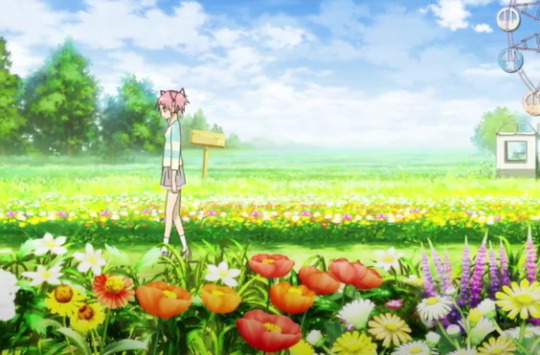
Like, we start off with Madoka in the spring. This definitely correlates with her wish to reset the corrupt system of magical girls and witches. She creates a new design for the system and gives herself and the other magical girls hope with the new start, heavily leaning into the themes of rebirth and hope tied to spring. Spring also represents transformations, and it nicely conveys Madoka using hope as a propelling force to her becoming a goddess.

When Sayaka enters the scene, it's summer. It represents her initial hopes and optimism toward becoming a magical girl, and her overall innocence. Her desires for romance and passion tied to her wish to be with Kyosuke also embody some of the core symbolic ideas associated with summer.

Now Mami enters the scene in the fall, which is often associated with themes of adulthood, maturity, and death. This pertains to her resourcefulness and maturity that stems from her dealing with the aftermath of her parents dying in the car crash. Mami also made her wish to avoid death.

Next we have Kyoko, with some of the most blatant symbolism with her ties to winter here. Kyoko made her wish to prevent her family from living in literal squalor, and the foundations of her wish were based upon her not wanting her family to have to endure such hardships and tough times, which winter is commonly connected with. After her father went ballistic, Kyoko was able to survive and live through the most difficult times in her life while sustaining herself as a magical girl and person. She also adopted the "survival of the fittest" mindset too, further representing her ties to the winter imagery shown here.

And lastly we have Homura entering in the spring! Her wish is based on saving Madoka and her initial hopefulness in doing so. She wanted to have a fresh start, a chance to redo her meeting with Madoka, which became the driving force of her life. Spring is heavily tied to new beginnings and transformations, which certainly embodies her change in personality and demeanor with all of the timeline resets.
Homura entering during the spring also foreshadows her transformation into a literal devil; this significantly parallels when Madoka enters in the spring, which is representative of her transformation into a goddess. Currently obsessing over these parallels btw.
#pmmm#madoka magica#puella magi madoka magica#homura akemi#madoka kaname#sayaka miki#mami tomoe#kyoko sakura#madohomu#long post#longish post#analysis#pmmm rebellion#madoka magica rebellion#madoka rebellion#pmmm analysis#my post#mine#mahou shojo madoka magica#500
574 notes
·
View notes
Text
My favorite details in Castle Lecter's set design
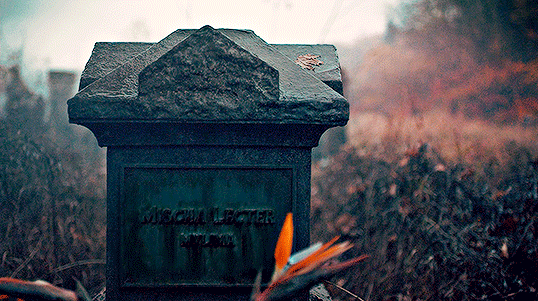
1. The Lecter family crest pays homage to the Hannibal book cover.
It references Milan's biscione, a snake devouring a man, which appears on the coat of arms of the Visconti and Sforza families (from which Hannibal is descended on his mother's side).
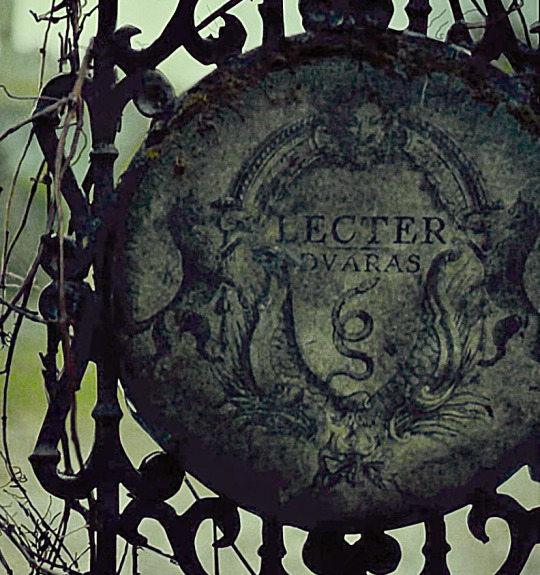
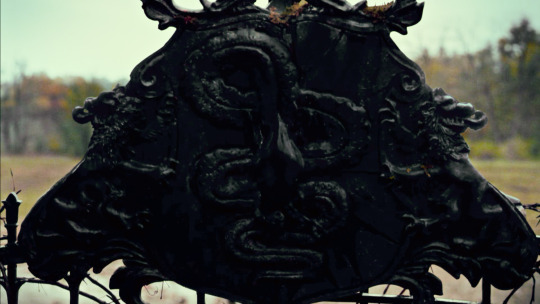

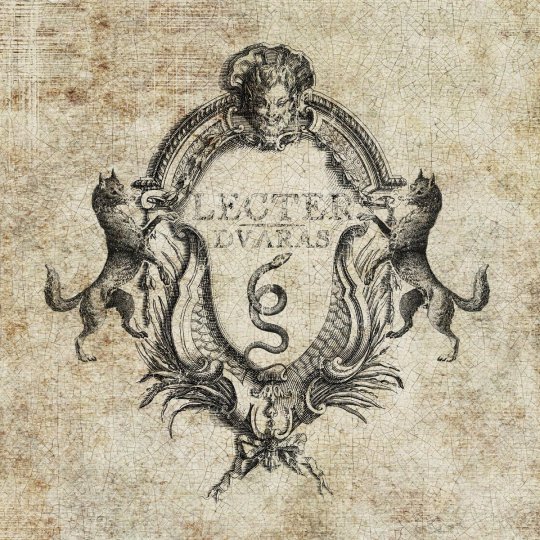
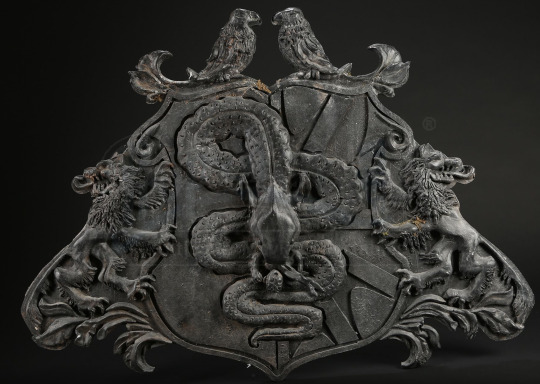
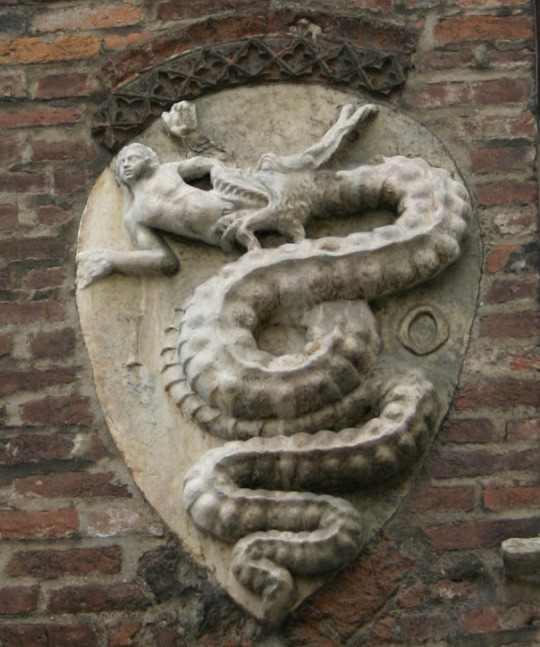
SIDE NOTE: One of Hannibal's favorite pastimes as the curator of the Palazzo Vecchio was reading about his ancestors:

Funnily enough, the Visconti-Sforza commissioned their own tarot decks in the 15th century, so Hannibal might've been studying those in the Palazzo library around the time he designed his Vitruvian Man tableau. Here's the original Visconti di Modrone Three of Swords vs an artist's reproduction:
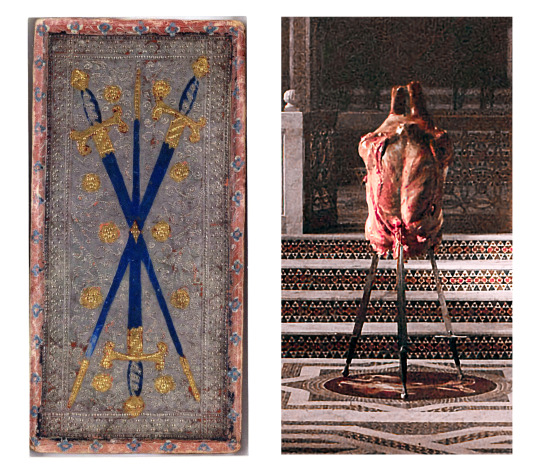
2. Pheasant & Raven imagery
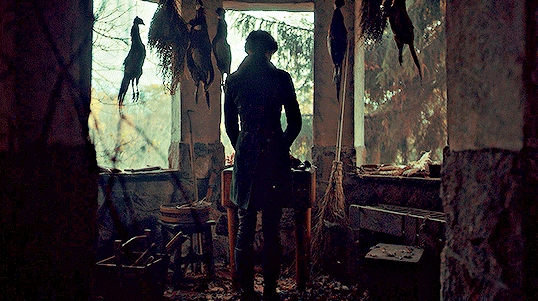

The Chiyoh/Abigail parallels are strong, but Chiyoh's symbolic prey animal is a pheasant instead of a deer! She uses pheasant quills as decoration for her dinner with Will, and there are some taxidermied pheasants in the hunting lodge we didn't get to see:

But my favorite detail is how she uses a pheasant bone to kill the Caged Man! Even a prey animal has sharp edges.
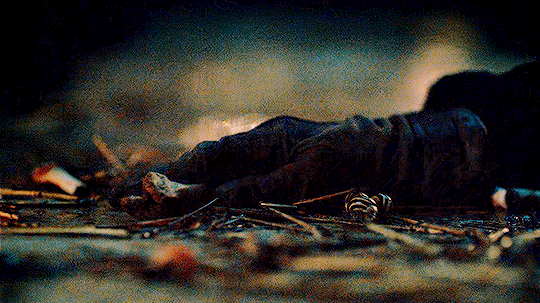

Meanwhile, ravens represent Hannibal's imposing presence haunting the estate. We see them on the Lecter family crest and taxidermied by the fireplace.
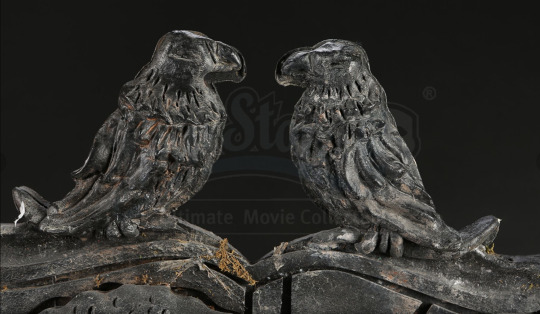
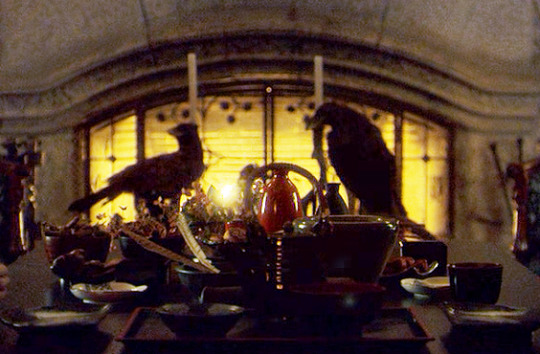
Doubled birds of prey motif... a nod to how Will is joining Hannibal as a predator?

All the hawk paintings could also just be referencing this single line in Hannibal Rising:

SIDE NOTE: Over in Florence, Hannibal is keeping in the bird theme with a feathered arm ham wing and a nest of green bean asps for his dinner with Sogliatto:
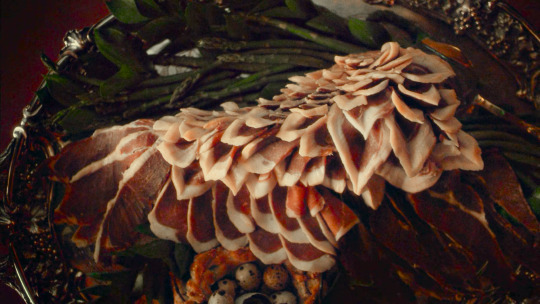
3. A Shrine for Mischa?
There's a deleted scene in the script where Will spots a Shinto shrine while snooping:

A small version of this shrine appears above the fireplace. It includes a pair of birds of paradise, the same flower Chiyoh leaves on Mischa's grave:

If you've read the books, Mischa's presence is also palpable in the deer heads watching over their dinner (not that we got to see them lol):

4. The way the painting above the fireplace is cut off makes it look like an oni glaring at them! Creepy!
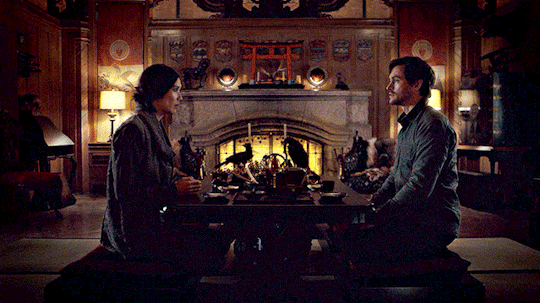
Or maybe it's meant to look like Enma, the Buddhist King of Hell, who is depicted in the painting on the ceiling in the original production design (The Fever of Tairo no Kiyomori by Tsukioka Yoshitoshi, 1883):

It's actually this Rorschach of a landscape based on Old Plum by Kano Sansetsu (1646):
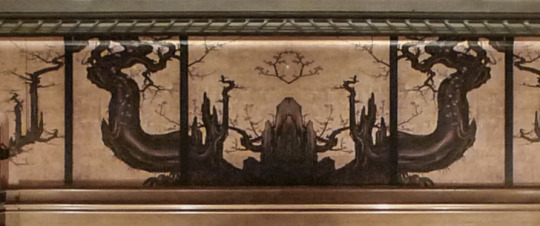

5. Japanese family crests (mon) on the curtains
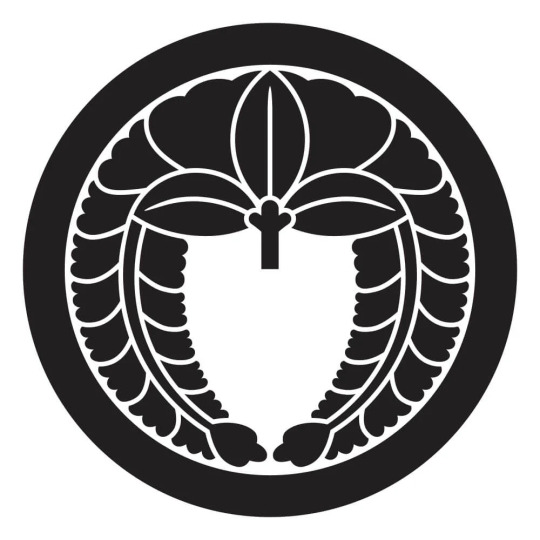

The Secondo scene uses the weeping wisteria family crest (sagari fuji mon):
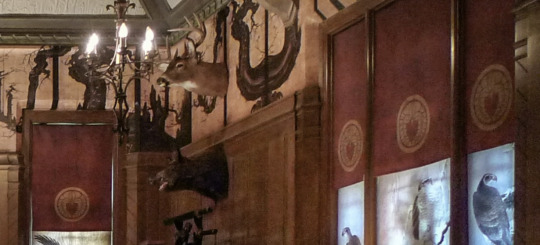
The name Murasaki means wisteria, so I assume this crest represents her. It's doubly fitting, since in real life, this is the Fujiwara crest, and Lady Murasaki's namesake (Murasaki Shikibu, author of the Tale of Genji) was a Fujiwara.
The original production design uses a princess tree family crest (kiri mon). Not sure if there was any symbolism to that choice, but they didn't go with it in the end.

98 notes
·
View notes
Text
One of my favorite things to do is discover new parallels and breadcrumbs in ACOTAR that SJM strewn for us in her writing.
SJM has been actively planning the Archeron sisters’ books since ACOMAF.
In an ACOSF interview, SJM talked about how while editing ACOMAF, she was currently writing ACOWAR and already thinking about the journeys Nesta and Elain were “in the middle of,” laying the foundation for their books after she infamously pitched her editor their stories over drinks.
Which brings me back to the larger Sleeping Beauty meta that Elain and Azriel have been interwoven with throughout the series and a prediction I have for their book.
Let’s begin 🤓
THE EVIDENCE
In ACOTAR, the inner shields of a characters’ mind are a large part of the imagery surrounding them, as seen through Feyre’s Daemati powers.
Let’s start by looking at Elain’s:
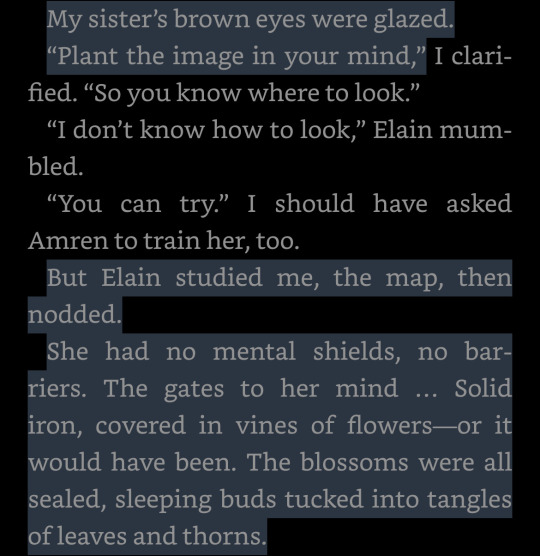
Solid iron. Covered in vines of flowers. Blossoms sealed, sleeping buds tangled in leaves and thorns.
This imagery screams Sleeping Beauty. And it also harkens back to the post I made about the imagery of the beasts in the Hewn City, who Feyre compares to Azriel and Cassian.
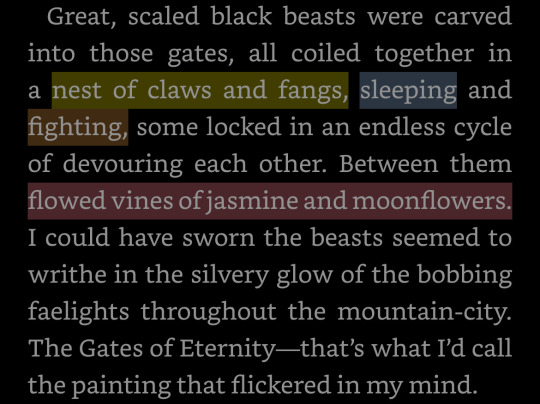
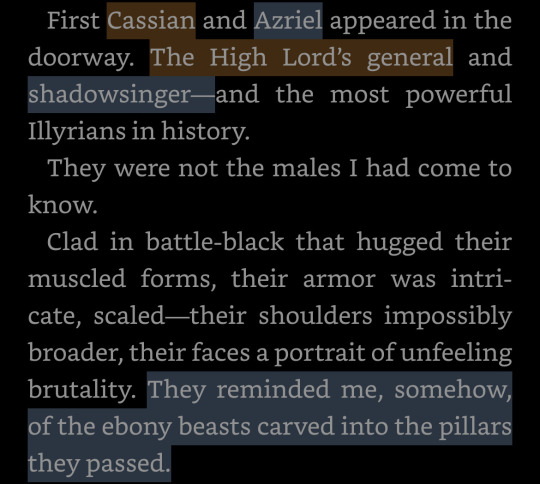
This repetition of imagery and symbolism isn’t a mistake. The sleeping beast amid vines of jasmine and moonflowers. It’s a deliberate echo of language used to tie both couples and their themes together.
Which then leads us to Nesta’s mind:
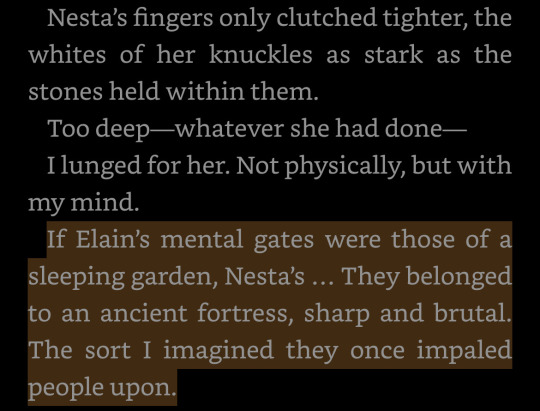
Nesta’s mind evokes images of war, a continually repeated motif that aligns with Cassian, their larger roles in their family structures, their drive to fight and protect, and for Nesta in particular, the visual manifestation of what she has to overcome in her journey. Not just within herself but with Cassian.
How do we know? Well, SJM told us.
In ACOSF, when Cassian and Nesta’s mating bond is revealed.
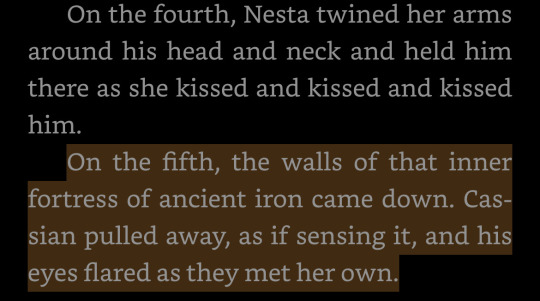
It’s only after Nesta bares her soul to Cassian and they meet in their mutual coupling of acceptance together that their mating bond truly comes to light and the threads of that bond are finally woven together in harmony.
So what does this mean for Azriel and Elain?
For the restless Spymaster, who “can’t sleep” despite his shadows imploring him to, and the Seer who’s “always dreaming these days,” I believe that like how Nesta’s inner walls came down when her and Cassian accept the mating bond, Azriel and Elain’s mating bond is somehow asleep, waiting to be awoken like the slumbering gates to Elain’s mind. Only then can their bond be brought to light like the sun at dawn, as right now it is asleep and half-hidden in shadows.
While the nuances of the narrative for how their “sleeping bond” would be revealed are still a mystery until we get their book, the foundation for a story of their love awakening and blooming is scattered across the series (“color bloomed high on Azriel’s golden-brown cheeks,” anyone?).
Some ideas to consider:
Could Azriel and Elain’s bond be Mother-blessed? Could the faebane arrow from ACOMAF have led the Cauldron to give Elain to Lucien instead, in defiance of the Mother? Did Koschei cast a spell to tie Lucien to another when he alone could be one to break Vassa’s curse with True Love’s kiss as a Spell-Cleaver? Will Elain and Azriel “weave” a bond of their own making?
I’m so excited to find out what SJM has in store for Elain and her journey where she will fully bloom with the love of her life 🌸💙
#acotar#elriel#pro elriel#elain archeron#pro elain#azriel#elain and azriel#azriel and elain#elriel supremacy#elain x azriel#pro azriel#acotar theory#acotar thoughts
127 notes
·
View notes
Text
Pink Floyd’s The Wall
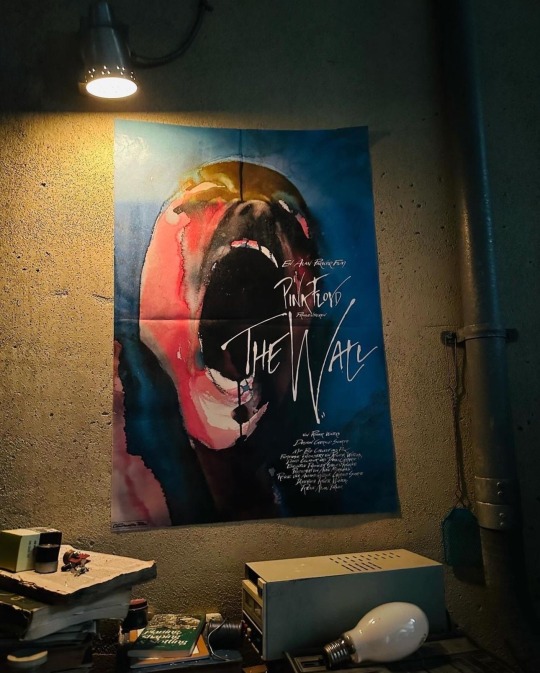
This BTS photo has really piqued my interest. Not just because it’s clearly a hint at something for season 5, but also because it happens to be one of my favorite albums ever. So, I thought I’d do a deep dive into how it might factor into the next season.
Full disclaimer: All these ideas I’m about to verbal vomit will make more sense if you watch the film here and/or listen to the album here. I truly recommend you seek it out. Far and away, it’s one of my favorite films/albums, and it’s stood the test of time. In fact, there are certain sequences that may be a little triggering in our current US political climate (I’m thinking of the “In The Flesh/Run Like Hell/Waiting for the Worms” sequence).
War. The Wall is about war; namely, the bitter uselessness of it. The film has a lot of anti-war imagery. Young soldiers wounded and vulnerable, doves exploding into crows, a bloody cross, etc. The film ends with a culturally diverse group of children picking up rubble from the war. There’s a beautiful image where a child pours out a Molotov cocktail. The meaning there is that children are taught to hate and kill, and once they are, the joy of youth is smothered by it. Now I can think of a few scenarios where this is relevant to our crew. This could have something to do with the war against Vecna, in that our kiddos are so young to be fighting this war, and that it will inevitably chip away parts of them. For some, it may take limbs, or even lives. There may also be an assertion that Henry Creel was taught to hate, rather than it being an inevitable part of him. El suggested this at the end of season 4, when she asserts to Vecna that Papa made him a monster. The nuance within the anti-war message of The Wall is that the main character, Pink, lost his father in World War II. Henry Creel’s father went to war (the exact same war, in fact) which is an interesting similarity, but I think greater parallels should be drawn between Pink and Henry Creel in terms of how their relationship with their father (or lack thereof) led to their emotional erosion. And when I’m referring to Henry’s father, I’m not necessarily talking about Victor, though their relationship may have been complex. I’m referring to Dr. Brenner as well. Now the major difference between Pink and Henry - at least, so far - is that Pink is shown to have a soft, gentle side to him. This gets smothered as his emotional wall grows taller. I don’t know if Vecna ever had anything of the sort, but we know that Will is nothing if not gentle. And if they’re going to draw parallels between Will and Henry next season, I have to think there’s some meaning in there somewhere.
Conformity. It should be noted that the film takes place during World War II, so the conformity themes were especially prevalent in those days - the days of Hitler and the Nazi regime. Pink attends a school where the children all wear masks and stand on an assembly line, eventually to be thrown into a meat grinder. All very heavy-handed symbolism, I know. But the idea is that society attempts to suppress individuality and corner the youth into becoming part of the mindless whole. Blessedly, toward the end of the school sequence, the kids all rip off their masks and rebel. Now, in reference to our friends in Hawkins, this could be a nod to how the group has never been afraid to be the “freaks,” and that conformity is meaningless to them. Stranger Things has always reveled in the beauty of being yourself in the face of societal labels. The Wall also utilizes hammers in much of its imagery, which is supposed to symbolize the hammer pounding a nail into submission. With the individual being the nail, and the oppressive whole being the hammer. To me, this hearkens back to the “hive mind” idea. The Mind Flayer operates from this hive mind, and so any deviation from this would be quickly and mightily suppressed. I also addressed the idea of the “hive mind” in my theory about the Wrinkle in Time Easter egg, and how the planet Camazotz adopts this same concept (read here if you feel so inclined). Will Vecna be this deviation? If not, who will? One of the kids? Will Dart break away from an army of demogorgons to save Dustin? I can’t see the Mind Flayer being thrilled about it regardless of how it manifests.
Emotional isolation. Pink undergoes a descent into emotional isolation. The wall itself is symbolic of the emotional wall he builds around his heart, insofar each negative event in his life is “another brick in the wall.” Once his emotional isolation is complete, he becomes callous and disconnected with others. He fantasizes about committing atrocities, even becoming a Hitler-like figure in his imaginings. Such emotional isolation is likely present within Vecna as well, as only someone with a real disconnection from their emotions could kill people in the ways that Vecna has. That scary face on the poster, in fact, is emotion, trying to break free of the wall. A scream of agony from within. Perhaps the Duffers will explore this within Vecna. Perhaps Vecna has some small shred of humanity left that the group will try to capitalize upon. At the climax of The Wall, Pink puts himself on trial in his mind with a judge that is a literal asshole (yes, it’s as batshit as it sounds), and the wall is torn down within him. The album ends with a spoken message that loops into the beginning track, suggesting that the conundrum of emotional wall-building will never end. Perhaps the group will attempt to tear down Vecna’s emotional walls. The Duffers are good enough writers to make us feel at least some empathy for Vecna, if we hadn’t already, and this might just be a continuation of this. There is also the possibility that one of our other kiddos starts to emotionally isolate. It could be any of them: Mike, Will, Lucas, Dustin, El, or Max. I’m less inclined to believe it would be one of the older kids, though they’ve all certainly got their own demons. None of them will become as twisted as Vecna, of course, but I could see them struggling against their own emotional walls. We’ve seen Max do a bit of this already. It would be a real shot to the heart if the Duffers utilized a deeply sad track like “Nobody’s Home” or a wistful, melancholic tune like “Comfortably Numb” to describe Max’s consciousness literally being absent from her at the moment. I think Will is also an ideal candidate for this concept, especially if (as I suggested earlier), we are going to draw similarities between him and Henry Creel. The ending song on the album, “Outside the Wall,” postulates that those who truly love you will walk up and down outside your emotional wall, banging on it, trying to tear it down and thus forge deeper connection. We’ve seen this happen with Max a bit, and I could certainly see it happening with Will, too.
Mental illness. Pink is suggested to have a mental illness. He’s not particularly easy to slap a diagnosis on (though based on the information we do have, I might have put him in the schizoid/schizotypal/schizoaffective territory. Depression with psychotic features at the very least). Mental illness isn’t a topic that heavily explored in Stranger Things, though season 4 definitely had some poignant things to say about depression. But I’m wondering - if they do decide to touch on this somewhat - if this will hint at a deeper dive into Vecna’s psyche. Killing small animals is generally a precursor to actual murder, and this was certainly the case when it came to Henry Creel, but we have yet to really unpack all of this. We’ve gotten hints. Vecna noting that he “never forgets a kill” and “they are always with me” is a very interesting concept I will be curious to learn more about.
I would love to hear any additional thoughts on this.
#stranger things#st5#st5 predictions#st5 speculation#st5 theories#pink floyd the wall#pink floyd#the wall#will byers#lucas sinclair#max mayfield#mike wheeler#jane hopper#dustin henderson#henry creel#vecna#001 stranger things#001#stranger things 5
65 notes
·
View notes
Note
Something I've been chewing on that I do wonder if you have any thoughts on.
What is the intended characterization/symbolism of Yang's semblance. Jaune is a healer/support. Ren learned to control his emotions and then grew empathetic. Qrow has his bad luck which is probably a defense mechanism with consequences from the bandits that raised him and Raven.
Taiyang's description of Yang's semblance is the closest to an analysis the audience has gotten and that is - "basically a Temper Tantrum". Very interestingly the narrative has so far let that description stand uncontested. And I believe you were the one that did the analysis that Yang's problem was overly depending upon her semblance as a finisher.
Also fun to consider how one of the ways that Yang has her parallel with Cinder is with the fire association... which for Yang is just actually her preferred ammunition and the go to imagery for her songs that I can recall off the top of my head except for temper metaphors.
that was me yeah
a core theme of yang’s character is that she’s made of contradictions and cannot be easily defined or fit into a single box. this is true of every character in rwby—there’s always more than meets the eye, complexity beneath the surface—but yang as a character is subject to other characters’ struggle to parse who she is. tai sees a temper tantrum, ruby sees invulnerability, blake has been on an emotional journey spanning six volumes of just learning to see and love yang’s whole, complete self. yang is raven’s daughter, after all—but she’s also summer’s daughter so much that the resemblance screams itself out of the screen.
so. her semblance.
in the story, it’s been described three different times by three different characters:
ruby: “every hit makes her stronger, and she uses that to fight back. that’s what makes her special”
tai: “basically a temper tantrum, great in a bind, but it won’t always save you”
blake: “his semblance is like yours, he absorbs energy through his sword, stores it up and sends it back when he’s ready” (+ yang feeling it’s “cheap” that he “gets to dish out damage without feeling it”)
<- three bears.
in goldilocks terms, yang’s semblance is “too strong” (ruby sees her as invulnerable), “too weak” (tai sees the power it grants her as essentially hollow, false) and “just right” (yang is neither invulnerable nor fragile and her semblance is just a part of her). i also think that what yang says of adam’s semblance is more revealing of her own self-perception than necessarily being meant as an objective critique of adam—it’s not “cheap” to parry/riposte and in fact yang’s growth as a combatant post-beacon looks like learning to fight more defensively and evasively, less reliant on soaking up damage/power for explosive finishers.
insofar as there’s a meaningful difference between adam needing to block hits vs yang not it’s that yang’s semblance gives her a bit of a cushion—she can still riposte even if she misses the parry—and in all honesty i think probably comes down to their kit. yang is a hand-to-hand fighter. she’s blocking hits with her forearms and, gauntlets or not, she’s going to feel that. the specific damage-absorption mechanics of their semblances cater to their fighting styles.
but, yang feels that it’s “cheap” for adam to absorb energy through his sword rather than his own body, because yang takes a certain pride in being able to get back up after being knocked down. her idea that she must take damage before she can deal it back twice as hard is probably not a real, immutable characteristic of her semblance but something that developed in response to how yang herself copes with trauma—it’s a way of, i think, regaining a sense of control and security by telling herself that it’s okay if bad things happen because it will just make her stronger in the end.
the narrative challenges this way of thinking post-beacon—losing her arm and being left behind did not make yang stronger, receiving support from trusted adults like oobleck and port and reuniting with her friends/family is what made her stronger. learning to accept help and treat herself with more compassion is making her stronger. exploring who she is apart from ruby is making her stronger. this is the direction she’s growing in emotionally—that being hurt doesn’t make her strong, healing makes her strong—and her use of her semblance is shifting in tandem with that (still pops it as a finisher quite often but it is pretty rare since v6 that yang uses it to gain the upper hand in fights she’s at risk of losing, bc these days she’s more focused on evasion/outmaneuvering opponents to create openings for her semblance to end the fight)
and then it’s connected to yang’s anger (and fear, as when she gets between neo and ruby) because both the feelings and the semblance are in essence a self-protective response—yang gets angry when she or someone she cares about is hurt and uses that anger to protect herself and/or the person she loves. her semblance is about taking painful things that happen to her and transmuting that into the power to defend herself. same thing.
i don’t actually think that her semblance is hooked into her anger in the, like, mechanical sense (we’ve definitely seen her pop the semblance in context where she’s having a GREAT time, for one)—the correlation arises from yang’s anger being motivated by protectiveness and a desire to not be hurt, which is also what manifests in her semblance.
i would argue that “basically a temper tantrum” is meant to be read in context with ruby’s “that’s what makes her special” and then both those extremes are brought to a resolution by blake’s neutral description of what burn is, mechanically; in that sense i don’t think that tai’s analysis has been left uncontested except insofar as yang didn’t argue with him—but conversely, tai more or less tells her to think of her semblance as a risky weapon of last resort and yang went “k” and started using her semblance more, so i think it’s less that yang takes his advice at face value than it is yang recognizing that tai raises a generally good point [being creative and flexible is valuable] and thinking okay, i can probably get more out of my semblance if i try new things.
her position is that burn is normal (“how is me using my semblance different from someone else using theirs?”), and the way she takes this advice on board reflects that—if someone else relied on their semblance for just one specific tactic and nothing else, what advice would they be getting from their instructors? push yourself further, test the limits of what you think you can do, get out of your comfort zone. that’s what winter tells weiss when she’s struggling! that’s how RNJR are taught in v5! tai views burn as fundamentally different from other semblances, and his advice really comes down to “don’t rely on it, you don’t need it.” but yang disregards that part of what he tells her entirely. she quietly sorts through what tai tells her and only keeps what she thinks will actually help her improve—which is, in itself, of a piece with her semblance. she takes the ‘hit’—the harsh and rather unfair criticism—and then filters/converts it into something more constructive.
(there is also some interesting subtext here with the protective/self-protective drive behind both yang’s anger and her semblance and tai’s perception that the semblance is a “temper tantrum”—which aside from framing burn itself as abnormal also casts yang’s anger as irrational, childish, out-of-control. given the dynamic of yang’s childhood situation, the parentification and leaving yang and ruby alone at home for extended periods of time and over-identification of yang with raven plus favoritism toward ruby… and factoring in tai referring to yang’s anxiety and post-traumatic depression as “moping” well. across the board he seems either unwilling or unable to seriously/genuinely engage with yang’s feelings so how much of his perception that yang has “temper tantrums” follows from outbursts she had when overwhelmed as a child or young teen that tai didn’t take seriously or chose to ignore rather than deal with the root cause of neglect/trauma?)
98 notes
·
View notes
Text
light, death, and the commedia dell’arte: an analysis on lucanis’ name symbolism and what that may mean for his arc & endings
i was doing some thinking on lucanis’ name recently, and there was something that i knew felt familiar from my days in high school latin class, so i did some digging and now i feel like i may be onto something in regards to what lucanis’ character arc and companion quest could be about. from what i could research online—and definitely feel free to correct me if i got any translations wrong:
‘lucanis’ has associations with light/dawn. lucania was the name of a historical region in southern italy. just a quick overview from wikipedia:
Historians at University of Naples Eastern Studies concluded that the root of the name Lucania is derived from luc, the Osco-Sabellic peoples word for light, which has the same meaning in the Latin idiom. The people that moved from the Osco-Sabellic tribes to occupy the land east of the Sillaro River, which was an area associated with the morning star, Lucifer (Latin for bringer of light). Therefore, Lucania means eastern land or land from which there is light.
what sticks out to me most of course is the parallel with lucifer, which i’ll discuss more about later—but the main takeaway is that his given name is pretty much embodying the idea of light, consistent with ideas of hope/dawn/renewal.
but his surname has a very different tone and connotation. ‘dellamorte’ means ‘from/of death’ in italian. (again, if any italian speakers have a better translation, pls feel free to correct/expand on this!)
juxtaposing these two names together is a very interesting choice, and one i think was definitely intentional. you could think of his full name either being something hopeful (light after death / from death, light) or something sinister (from light, death / the death of light).
and i feel like this dual nature is exactly what his arc will explore. we know lucanis has magic-sensing abilities and from the latest trailer, straight up magical wings—it gives me a lot of “angel of death” vibes with, again, using the purple color of pride demons to highlight the bone structure. and of course a lot of pride demon imagery with eye motifs in his design + tarot card:


we learn that he has died from the short story The Wake. a lot of people have speculated that he faked his death, but what if lucanis did actually die? what if, on the verge of death, he made a deal with a pride demon to continue living?
what if lucanis’ arc is one of struggle to embrace either light or death? will rook be able to influence lucanis’ fate—be a vessel for the demon, be a death bringer, or free him from its influence, choosing to bring light instead? and this is where that “lucifer” dynamic kicks in. lucifer, a fallen angel, who rebelled against his father. will his arc mirror this with potentially him rebelling against caterina?
and then an interesting tidbit from the commedia dell’arte—and i might be totally overthinking this, but i thought it was interesting to mention nonetheless. commedia dell’arte is an italian form of theatre focused on masked type/stock characters.
from folk play research’s “Death and Resurrection in the English folk play and Italian Commedia dell’Arte”:
A common theme that runs through both the English folk play and many of the stories of the Italian Commedia dell'Arte is that of death and resurrection. In the latter, this generally involves the character or 'mask' of Pulcinella/Punchinello, who is frequently killed through misadventure or executed as a result of some misdemeanor, but revived through some intervention, usually magical or demonic.
pulcinella’s mask does give me crow vibes…

however his arc may play out, i’m really excited to see. i think he’s most definitely has something going on with spirits/demons, and we have had a spirit companion in some way every game, so i think lucanis could be a really interesting addition to that list 👀 what do you think?
#lucanis dellamorte#dragon age#dragon age the veilguard#datv#dragon age meta#dragon age analysis#dragon age theory
27 notes
·
View notes
Text
Fairy Tale Allusions in Yugioh 5Ds
So I was rewatching 5Ds and Akiza's duel against the knight dude got me thinking about the fairy tale allusions in her design and arc, and thinking about it more got me to realize that 5Ds actually has a lot of loose fairy tale allusions throughout it. So here are just a couple of the ones I noticed:
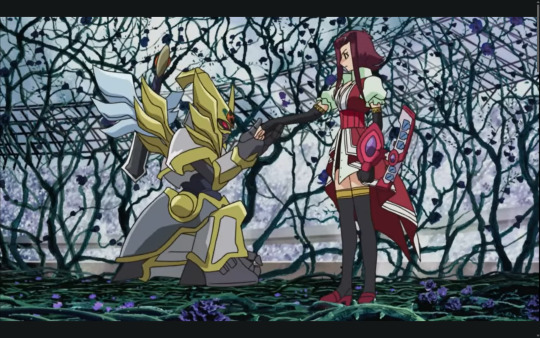
Akiza in general: Akiza's first duel of the series was already really heavy with the knight vs. witch symbolism. It also got me thinking about the "Princess, Witch, and Prince" theme from Revolutionary Girl Utena. A very basic rundown of what Utena says on it is that people will try to sort women into a box of good (Princess) or bad (Witch) based on how much they conform to the concept of what a girl should be like, a good Princess has to trade independence for protection from a Prince, any girl that doesn’t agree is a Witch. Problem is that no woman is ever just one of those things at a time, and Akiza definitely isn't. She is at first feared for her power, labelled the evil Black Rose Witch, and attempts to find comfort and safety in her "Prince" (Sayer). Only when she meets Yusei and the gang and finds acceptance from them and her parents do we see that she's actually a very kind girl. And even then, she doesn't go trading one Prince for another, she's never as reliant on Yusei as she was with Sayer and maintains her independence. Also just her deck in general carries the theme with fairy tale-like imagery (roses, knights, witches, fairies, and a dragon).
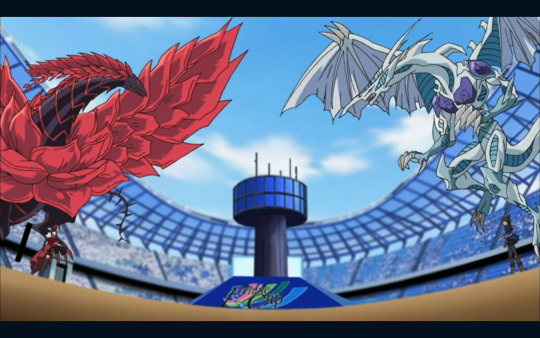
Akiza + Yusei: These two are basically Beauty and the Beast. I am a major faithshipping fan, but even if you take out the romantic aspects, it still fits. Yusei being Beauty and Akiza being the Beast for obvious reasons. The scene with Yusei waking Akiza in the hospital also gives major Sleeping Beauty vibes as well (this scene also owns my soul).
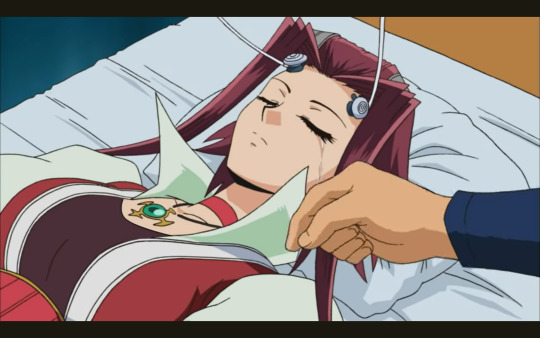
The rose imagery also still fits with both of them.
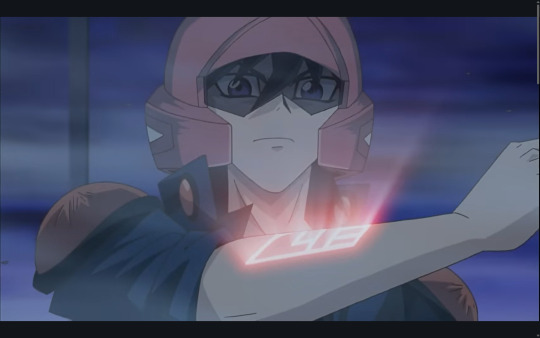
Yusei: He's Cinderella: he's a poor boy, goes to a ball that he wasn't supposed to go to (Neo Domino), has to leave at midnight (gets arrested), but leaves behind a "glass slipper" (the mark of the Crimson Dragon) that makes it so that the prince (Godwin) can track him down and give him another shot at freedom (not for altruistic purposes of course, but it still fits).
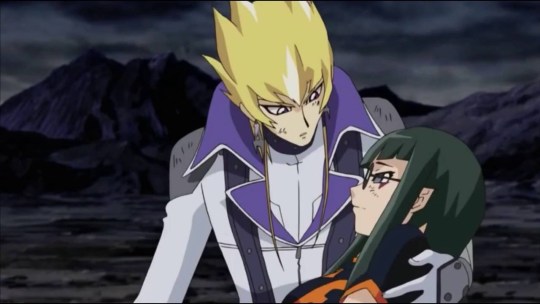
Jack and Carly: Scoopshipping are The Little Mermaid. The mermaid (Carly) falls in love with the prince (Jack), but for certain reasons, they cannot be together. Said mermaid makes a deal, by trading her soul, she gains legs (Dark Signer abilities + duel runner) which allows her a second chance to go after the prince. But the prince rejects her proposal (because she's undead and evil now), and the mermaid concedes. But being unable to hold up her end of the deal, she turns into sea foam and dies (turns into dust and dies).
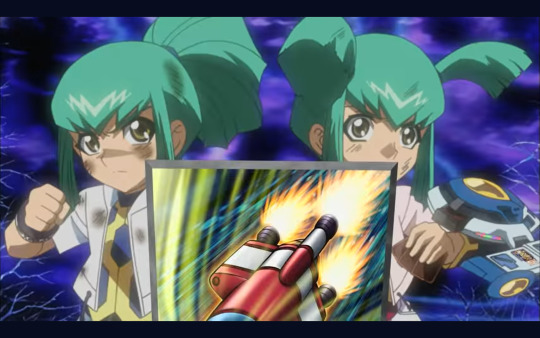
Leo and Luna: Luna's deck already has a loose fairy forest type theme (and in the manga, has a Fairy Tale archetype). I want to say they're Hansel and Gretel. Has the same beats of two siblings getting lost in the woods (Luna with her spirit world adventure, Leo dueling Devack with "Closed Forest" up). But most of it comes from their duel with Devack, in which Hansel (Leo) stalls the witch (Devack) for as long as possible until Gretel (Luna) can kill the witch by pushing him into the oven (win the duel). You could also say that Luna's arc of freeing Ancient Fairy Dragon has elements of Rapunzel (saving the princess from the witch that locked her up).
Those are at least the ones I noticed. I doubt all of them were intentional but it's interesting when you make the connections. Let me know if there's any I missed because I'm not done with my rewatch yet and don't have anything for Crow. Feel like Team Satisfaction and Neo Domino City have Wizard of Oz parallels, but haven't got enough info to say how yet.
#yugioh#yugioh 5ds#aki izayoi#akiza izinski#yusei fudo#jack atlas#carly carmine#leo and luna#rua and ruka#faithshipping#scoopshipping#revolutionary girl utena#rgu
91 notes
·
View notes
Text
The mirror crack'd from side to side;
'The curse is come upon me,' cried
The Lady of Shalott.
--Alfred Lord Tennyson
One thing that I appreciate about the ending of Rebellion is how reality literally splinters when Homura grabs Madokami's hands. It's such a visceral and compelling way to illustrate what is happening as everything that we took as "real" falls apart. This isn't quite what people mean by "breaking the fourth wall," but it's a similar effect, as it draws attention to an invisible barrier that we in the audience didn't even realize was there until it was broken. And of course it mirrors--pun 100% intended--the shattering of Homura's own soul gem moments earlier because any distinction between them no longer exists.
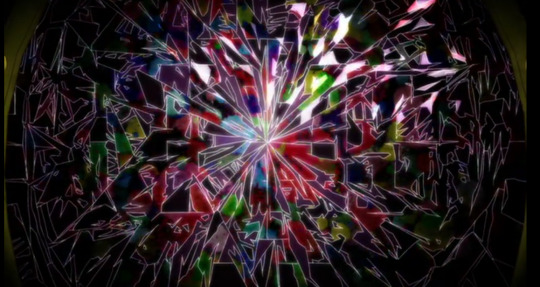
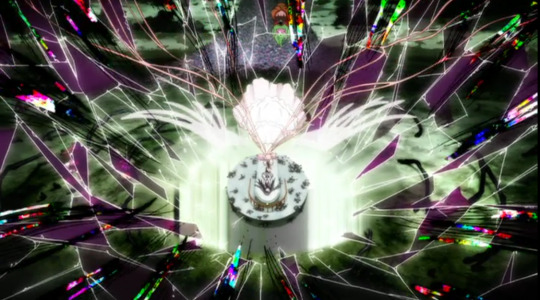
We often talk about a "mirrorverse" (thanks, Star Trek!) as a parallel universe where everything is reversed/inverted, but isn't that exactly what Homura has created here--a mirror universe?
And with the mirror come reflections. Lots of them. Everything is doubled, again and again.
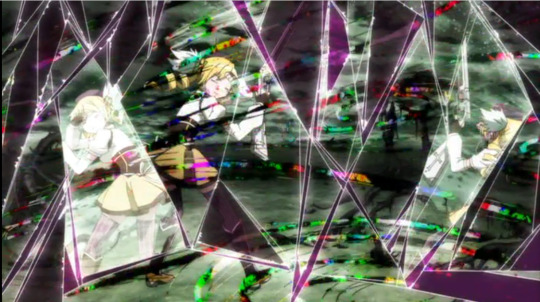
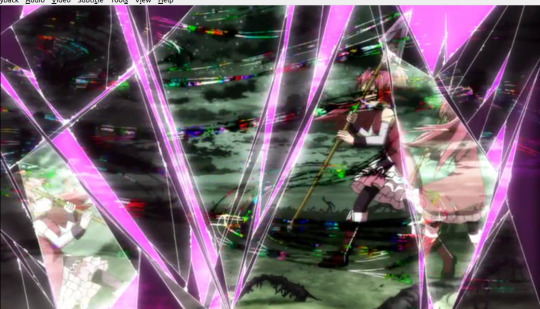
It culminates with the tearing apart of Madoka from the Law of Cycles, complete with the sound of breaking glass.
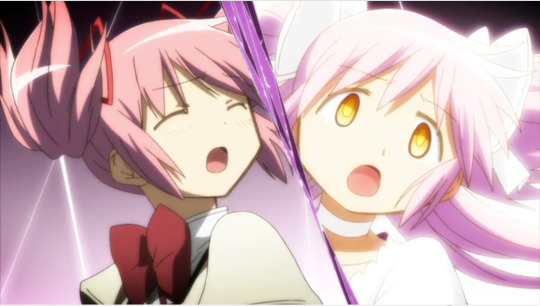
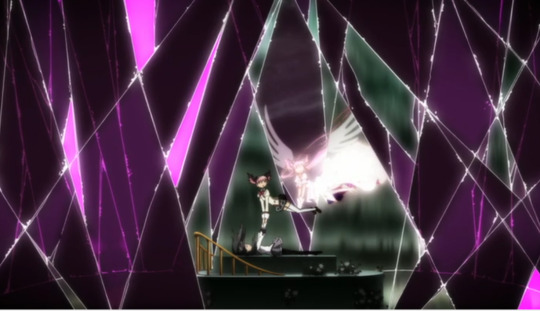
What I hadn't quite realized before I watched this scene in slow motion is that as the glass continues to crack, it ends up forming a shape very similar to Homura's own soul gem--both have simultaneously broken and re-formed. (Note that even with all the "cracks", a series of nested diamonds--Homura's signature visual motif--are visible within it.) Only then do the "curses" come out and envelop everything...

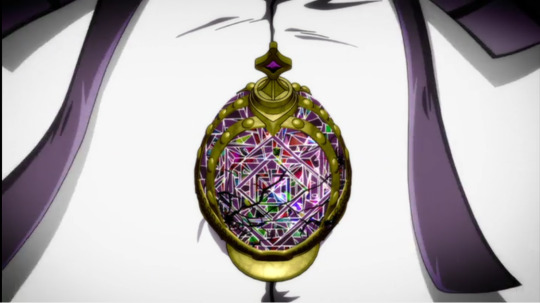
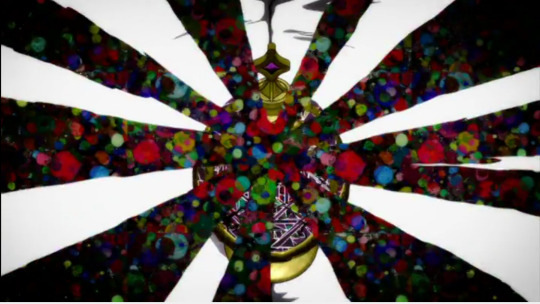
...which leads to this fascinating series of everyone and their reflections being swallowed up.
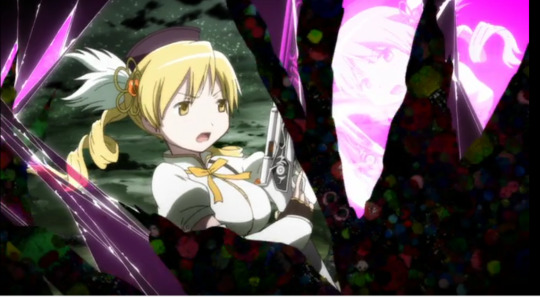
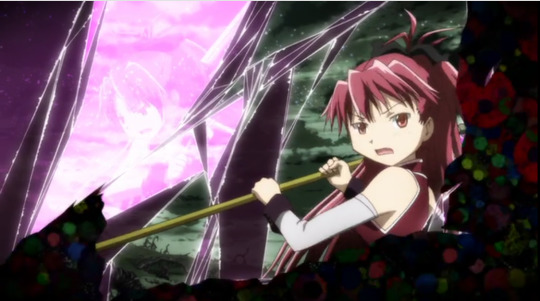
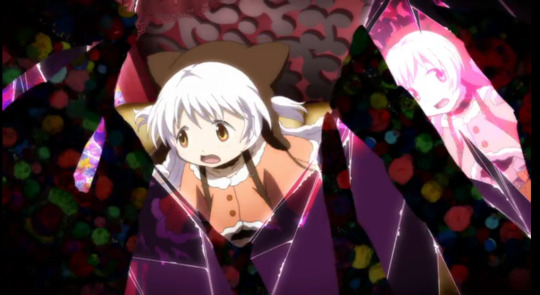
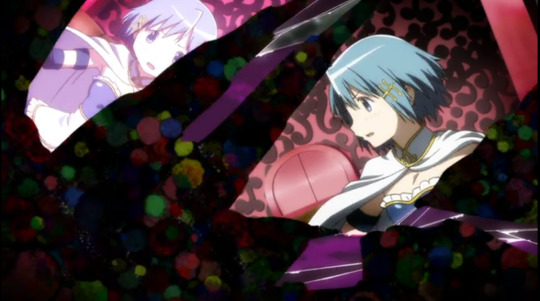
I'm not quite sure how to interpret what happens next, but there's actually two parts: a crystalline structure that comes first, followed by the "curses" themselves.

Both end up covering the universe--but the "curses" end up forming a shield-like design while the mirror fragments/crystals remain in place.
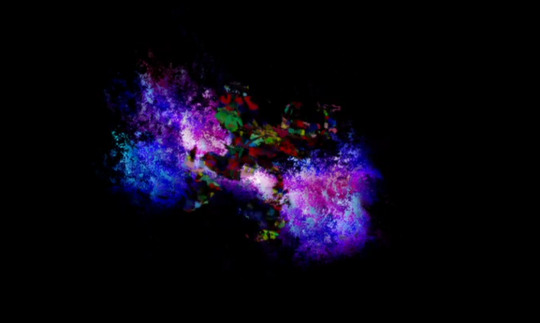

Then, of course, Homura shatters her soul gem in her mouth, and it re-forms into Dark Orb (omg, I cannot write that with a straight face), which is basically the same thing that we already witnessed with a different set of symbols. At this point, the cracked glass imagery disappears, having fulfilled its purpose: the universe might be different now, a mirror version of what it once was, but it's no longer broken because it has been remade.
Breaking soul gems/glass is a major visual theme in Rebellion--Homura shatters her own soul gem with a bullet (doesn't take, because it was never real to begin with) and she and Madoka shattered the soul-gem shaped glass "bell jar" the Incubators have put her in--and here it reaches its apotheosis along with Homura, in a compact and striking sequence. On first watch, this scene feels like it comes out of nowhere, but on reflection (sorry not sorry), it's clear the entire movie was building towards this moment from the beginning.
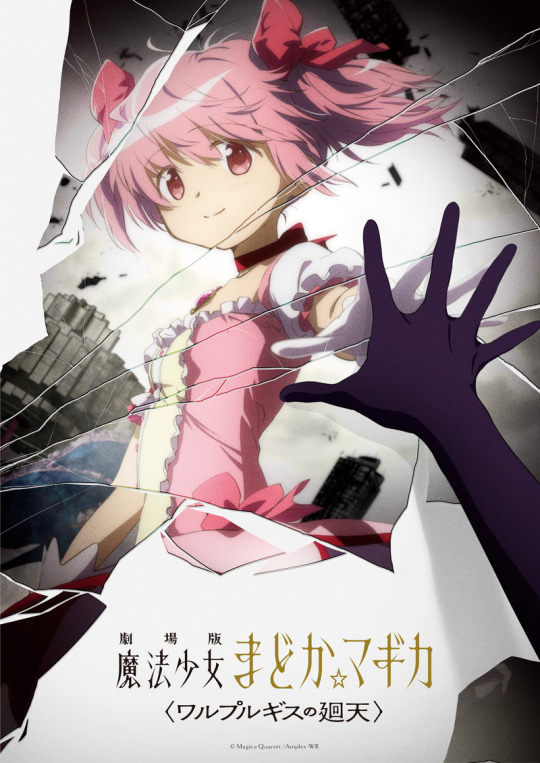
I initially didn't read too much into the first key visual for Walpurgis no Kaiten because I assumed it was a placeholder from footage already on hand because they hadn't actually made the movie yet, but looking at it again in light of this discussion makes me reconsider my stance. This is not to say that I think this particular image will necessarily appear in the movie, but it does tie into the themes established in Rebellion of broken reality symbolized by a cracked mirror, and of Devil Homura reaching out to Madoka (hands again!) but being unable to connect because of a barrier between them, one that Homura no longer can control. However, my guess is that Walpurgis no Kaiten will express these same themes with unique and different imagery rather than completely re-hashing that of Rebellion.
That said, we're clearly not done with this theme entirely, because the second key visual has Homura facing off against a mirror version (mirrorverse?) of herself.
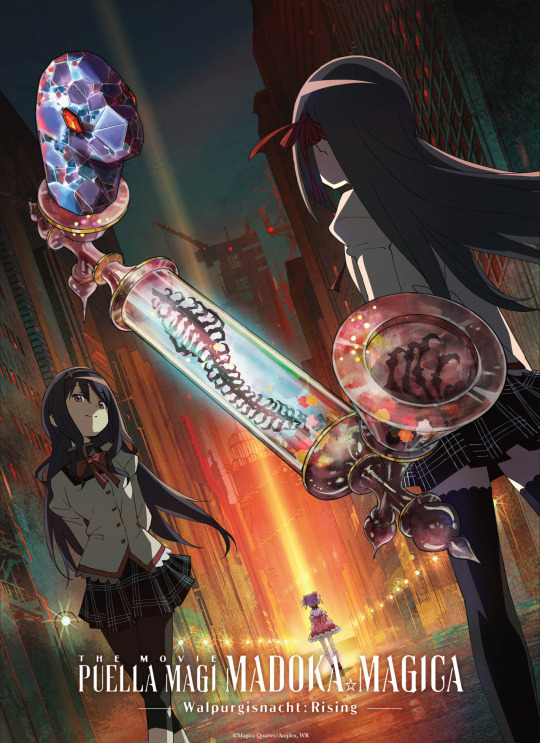
(in light of this discussion of cracked glass re-forming, that salamander head on the phone starts to make a lot more sense)
Furthermore, the trailer heavily features inverted/backwards writing, which also ties into Tarot symbolism and the concept of "reversed" cards--again emphasizing mirrors and mirror images. If Rebellion had echoes of Alice in Wonderland, it sure seems like Walpurgis no Kaiten is going for Through the Looking-Glass!
All the mirror/double imagery in Walpurgis no Kaiten didn't come out of nowhere--like so much of the movie, it appears to have been subtly foreshadowed in Rebellion, and is almost certainly a direct consequence of Homura's actions in this particular scene. All actions have consequences, and we'll find out what they are in the next movie.
tl;dr: It's all done with mirrors. :)
28 notes
·
View notes
Text
Revisiting the Rat Cook, Part 1: The Best Pie, and Lord Lamprey
This is the first part of a series I've been sitting on for a while, where I'm going to examine the symbols and themes present in the "Rat Cook" story, as relayed by Bran in ASOS Bran IV, and search reappearances of those elements throughout the rest of ASOIAF.
This series is predicated on the understanding that these books are rich with intentional symbolism, metaphor, and allegory, and that the repetition of these symbols and themes adds to their meaning.
In general, the symbols that are present in ASOIAF are limited by their ability to be inserted into the plot of the story (i.e. if the symbol of a stag killing a direwolf is important, there must be a way in which the characters are able to encounter such a scene within the plot's context). However, the metadiegetic legends that exist in-world for the characters of ASOIAF are not beholden to the same restrictions, and because GRRM is able to invent these myths in their entirety without restrictions on any of the individual symbolic elements, we can trust that each separate element of these in-world myths was placed intentionally.
With that in mind, I believe we can use stories like that of the Rat Cook as a sort of "road map" when looking at the reappearance of these same symbols and themes elsewhere in the story; I believe the "Rat Cook" story is the most distilled example of these elements. I don't mean to say that every instance of "rats" references the Rat Cook directly, but that the Rat Cook story provides a place where Martin is able to use these symbols in their most abstract form and describe their relationship to each other, so that when we see them appear again elsewhere in ASOIAF we might better understand what we are being shown.
So, among other things, the Rat Cook story is about a rat which eats rats, or a cook who serves kings; The Rat Cook story is about fathers and sons, about cannibalism, about trust, about vengeance, and about damning one's legacy.
This is likely going to be a 9-part series, but ideally almost all of these parts will be able to stand on their own. Each post will inform the next as I build my analysis, but hopefully each individual post is also interesting in its own right.
RtRC Part 1: "The Best Pie You Have Ever Tasted" and "Lord Lamprey"
This opening part, for better or worse, is going to retread some well-discussed ground: the clear parallels between the "Rat Cook" story and the incident in which Lord Manderly serves certain overlarge pies in ADWD The Prince of Winterfell, a scene lovingly dubbed "Frey Pie". However, as well-established as this comparison is, I want to begin here so I can begin to introduce how a closer analysis of the Rat Cook themes are present in this uncontroversially parallel scene, and how they might add more depth to interpreting that moment.
Not only does the scene evoke the same imagery, serving pie to the Lords amidst conspicuously missing sons, but the connection becomes even more direct when Wyman Manderly looks directly to the camera and says, “Hey reader, if you’re wondering where those Freys are, think back to any scary stories you know about pie”.
Okay, he doesn’t actually say that, but it’s close enough, and as much of a nudge we’re like to get from Martin (and which still went over my head on my first read through). Instead he does the next best thing, cueing Abel to sing while staggering past our POV:
"We should have a song about the Rat Cook," he was muttering, as he staggered past Theon, leaning on his knights. "Singer, give us a song about the Rat Cook."
Manderly seems to acknowledge the similarities himself, and most have noticed as well.
However, making the comparison between the story of the Rat Cook and Manderly’s actions is particularly interesting in their differences.
There are many ways in which Manderly’s pies, as a mirror, are appropriately an inversion of certain elements in the Rat Cook myth.
Returning to the scene as we see it in ADWD The Prince of Winterfell:
“Ramsay hacked off slices with his falchion and Wyman Manderly himself served, presenting the first steaming portions to Roose Bolton and his fat Frey wife, the next to Ser Hosteen and Ser Aenys, the sons of Walder Frey. "The best pie you have ever tasted, my lords," the fat lord declared. "Wash it down with Arbor gold and savor every bite. I know I shall."
“True to his word, Manderly devoured six portions, two from each of the three pies, smacking his lips and slapping his belly and stuffing himself until the front of his tunic was half-brown with gravy stains and his beard was flecked with crumbs of crust.”
Manderly takes on only some of the roles of the Rat Cook here. Despite his status as lord, he plays the role of the humble cook, personally serving Roose Bolton, Walda Bolton (née Frey), Hosteen Frey, and Aenys Frey, all standing in for the “Andal King”. In this way, the role of “Andal King” as someone who has official power and the role of “Rat Cook” as effectively powerless dissident are played out straightforwardly. Bolton and his allies are backed by their army and the authority of the crown while Manderly has no official backing of his own.
Wyman even physically resembles the Rat Cook; Wyman’s blue eyes indicate he is presumably pale, and Wyman is prodigiously large, to mimic the descriptor of “white, and almost as huge as a sow”.
However, like the “Andal King” himself, who had a “second slice” of his own son, it is Wyman Manderly, and not Bolton nor the Freys, who devours two portions from each of the pies. In this way, the roles have elements which are interchangeable.
Wyman is acting out both roles, which is especially interesting because in this comparison is a single most definitive contrast: The Rat Cook, most notably, is not punished for serving the pie, as "a man has a right to vengeance". Instead, he is punished for violating guest right.
Now, Wyman—who lost his son to the Freys at the Red Wedding—certainly has a “right to vengeance”, but betraying guest right is something which Wyman Manderly takes great pains not to do. Manderly conspicuously notes that he gave the three dead Freys guest gifts upon their parting, marking them as no longer guests under his roof, and subsequently, theoretically, freeing him to kill them. Manderly introduces the idea while Davos marks the distinction for the reader’s sake in ADWD Davos IV:
“The Freys came here by sea. They have no horses with them, so I shall present each of them with a palfrey as a guest gift. Do hosts still give guest gifts in the south?"
"Some do, my lord. On the day their guest departs.”
The Freys, on the other hand, as executors of the Red Wedding, are the most notable violators of guest right, while the Boltons contributed their part as well; both are being punished for that sin by Manderly-the-Rat-Cook here, marking the inversion of the story. In this iteration, the party serving the pie seems to warrant no judgment; instead, the pie itself is the judgment, served as retribution. With that connection in mind, it's worth remembering the other importance of the Rat Cook story, based on its placement in ASOS and which I think has often been overshadowed by Manderly’s “Frey Pies” incident.
In the Rat Cook story, after the Rat Cook's punishment, he spends an immortal future forever eating his own descendants, a scenario in which Bran describes the rats of the Nightfort as “children running from their father”. That eternal, kin- and legacy- devouring doom does not just come secondary to the punishment, it is a part of the punishment following the violation of guest right, and introduces the notion of an entire family being cursed for that violation... and, for good measure, is brought up in ASOS Bran IV, chapter that occurs only a few chapters after the Red Wedding itself.
In one respect, this is just another reinforcement for the reader of the sanctity of guest right and of the laws of the old gods. Coming so soon after the Red Wedding, the Rat Cook story hints at the fall of House Frey. Walder Frey, most culpable violator of guest right, has apparently doomed the rest of his dynasty to death, punished for his actions, the way that the Rat Cook, too, is a patriarch who creates not only his own ruin but also the ruin of his progeny. Although Walder himself is not literally tying the nooses, it is Walder who has metaphorically become the father "devouring his children" indirectly through his ruthlessness. Wyman Manderly, then, is merely an agent of that doom.
On the subject of the Freys being cursed by violating guest right, only one of the named consumers of the pie, Aenys Frey, is truly mirroring the Rat Cook legend by literally eating his own son, Rhaegar Frey. Both Aenys and Hosteen Frey, on the other hand, are specifically called out in the scene as being the “sons of Walder Frey”. It’s appropriate within the mirrored Rat Cook motif to invoke Walder’s name as patriarch as well as the promise of other “sons” that might succumb to their father’s insatiable appetite for status; this sentence invokes the dynasty of the Frey household. Indeed, Walder Frey himself also has shared motifs with the Rat Cook: like the immortal Rat Cook, Walder Frey has nearly innumerable children and grandchildren, and he too seems to refuse to die.
If a named heir in Westeros is like the ASOIAF version of Chekov’s gun, then the Late Walder Frey is sitting on Chekov’s arsenal; once he becomes the late Late Lord Frey, it’s going to explode. If that happens in an upcoming book, then the Rat Cook story might be setting up the idea of how an eventual succession crisis of House Frey might further this metaphorical connection, with this doomed family turning on itself, each running from the shadow of their father’s legacy like the Rat Cook's children run from him in the Nightfort.
Lord Lamprey
Now, to push through a little more symbolic linking between the Frey Pie scene and Lord Manderly:
If we consider the “pie” element as a key part of the Rat Cook story, then seeing a “pie” specifically in the hands of Wyman Manderly prompts a connection with a noted favorite of Manderly’s: lamprey pie. As early as ACOK Bran II, we learn that:
“His own people mock him as Lord Lamprey”,
Interestingly, we see in that same chapter a telling metaphor considering Manderly and lampreys not in a pie:
“Lord Wyman attacked a steaming plate of lampreys as if they were an enemy host”.
Considering Wyman’s lampreys-as-enemy association makes for curious contrast later, in ADWD Davos IV, as Manderly is feigning allegiance with the hated Freys. Here, Manderly has just stepped away from the feast in order to secretly treat with Davos, and the food served may contain more meaning than at first appears:
“In the Merman's Court they are eating lamprey pie and venison with roasted chestnuts. Wynafryd is dancing with the Frey she is to marry. The other Freys are raising cups of wine to toast our friendship.”
The reappearance of this noted lamprey pie might take on more significance knowing that some of those eating it become a pie later on. The reminder of the association between Manderly and his lamprey pies seems even more intentional when the “Lord Lamprey” nickname conspicuously returns as Bolton’s men search for the missing Freys in ADWD Reek III:
"You did not find our missing Freys." The way Roose Bolton said it, it was more a statement than a question.
"We rode back to where Lord Lamprey claims they parted ways, but the girls could not find a trail."
Invoking his nickname in this scene draws a connecting line between Manderly’s favorite pie, the “enemy host” of lampreys, the missing Freys, and “lamprey pie” being served as a symbol of the fake “friendship” between the Freys and Manderlys.
If that Frey-Manderly friendship is marked by mentions of lamprey pie, and Manderly loves to eat lamprey like he would eat an enemy, and we see in The Prince of Winterfell that Manderly apparently loves to eat his enemies, having two portions of each Frey pie, we might think that the Freys are being paralleled with Manderly’s favorite pie filling: lampreys. If that is the case, then comparing the punished Freys to lampreys is a scathingly fitting image, and I mean that literally.
Considering that carnivorous lampreys latch onto fishes to slowly eat the fish’s blood and flesh while the fish still swims, then looking at an image like this makes for some serious symbolic resonance if you consider the Tullys as fish (as they often are described) and the pie-filling Freys as pie-filling lampreys. It certainly provides a strong visual metaphor for the Frey’s “late” and half-hearted vassalage to Hoster Tully, how they dealt with Catelyn, and how they are now parasitically using Edmure—he sits in Riverrun at the end of ADWD, but with Freys latched onto him, bleeding him like they did his family.
This series is otherwise about pies and rats, not lampreys, but I will mention a few other interesting associations with lampreys that are worth looking into. The Stokeworths, when they are desperately trying to secure a match for Lollys, serve each of their prospective suitors lamprey pie, perhaps a signaling of the Stokeworth’s parasitic place at court, or the attitude towards their search for their daughter’s match. Note that in that context, Littlefinger remarks that he loves lamprey pie, perhaps fittingly for someone who has risen high by making use of his parasitic attachments to those more powerful. By contrast, when our intrepid advocate for truth and justice—Davos—is jailed after his return from the Battle of the Blackwater, he is served lamprey pie in the dungeons, but finds it “too rich” to eat. We have already seen that Davos has no stomach for the blind flattery that some of Stannis’ other lords have, and this scene describes that same character trait. I believe there are even further associations that are worth investigating, but for the sake of this essay, we must move on and end here for now.
In the next part, I'll focus on how it's relevant that the Rat Cook's pie and Manderly's pie were both allegedly "pork" pies, and where that reappears as well.
#asoiaf#a song of ice and fire#rat cook#asoiaf theories#literature analysis#wyman manderly#walder frey#RtRC
70 notes
·
View notes
Text
consider the rakshasa in 2x02 as an allegory for john.
he's just died, and this episode is about sam and dean's grief, as well as their struggles as they try to move on from his death. the circus itself represents hunters and the hunter society they've just newly discovered (also in this exact episode), and the rakshasa is a monster hiding within that culture of misfits. much of 2x02 is from dean's perspective, and dean has just come to view his father in a violently negative light (consider the end of the episode, where he destroys the impala in order to symbolically hurt john).
so the rakshasa as john. the monster can turn invisible, similar to how john's presence in the narrative is oppressively absent: in season 1 he's missing, and now in season 2 he's dead. yet he's always present in spirit, even though sam and dean can't see him. he's an invisible force weighing down on them, there yet not.
the rakshasa also preys on children. this could be symbolic of the way sam and dean are rather emotionally immature, frozen in time due to the abuse they suffered as kids. indeed when children are featured as guest stars in an episode, they act as allegories for dean (see 1x03 and 1x18). the same thing is true for teenagers, who are typically paralleled with sam (see 1x05 and 1x08)—this present, if sparse, theming could indicate the emotional states of the brothers, or the points in their respective lives which have shaped them most strongly: dean lacks a childhood because he was forced to grow up too fast and therefore imprints on children, and sam is stuck a rebellious teenager, allowed to grow into adolescence due to being sheltered but perhaps stunted in growth as he becomes aware of the world around him and his own situation, and as he develops a lasting resentment toward john. therefore, the invisible monster john winchester is preying on sam and dean, both in their literal childhood and as their present-day selves, trapped in a state of immaturity due to a life of abuse and neglect.
i also like the little detail that the rakshasa lives in squalor, as this can be compared to the motel rooms and the car that sam and dean grew up in: their constant instability and run-down, cheap housing that sheltered them their whole lives. it's a stark difference from the comfort of a stable home, and combined with the nomadic lifestyle of a circus, there is a very striking parallel between the rakshasa's life and the life that john forced his children into.
(an interesting aside, but the rakshasa feeds in 20-30 year cycles, which is quite similar to the cycle azazel appears to be working with to create new generations of special children, which is around 23 years. not sure if this is intentionally drawing a parallel between azazel and john, but i wouldn't be surprised given the tangled-up, impossible web they exist in together.)
in the end, sam is the one who kills the rakshaka, as dean has been immobilized by it (the imagery recalling that of 1x22, where dean is immobilized by an azazel who looks like john; additionally, one can compare the emotional arc dean is suffering at the moment, metaphorically paralyzed by john's final wish and his inability to act on his own because he has spent his whole life a soldier to john's instruction). if the rakshasa is john, then it implies that sam will ultimately be the one to save dean from his conflict, the one to free him of his paralysis—and he does in 2x09, when dean embraces his codependent relationship with his brother, abandons his father, and throws down his gun to choose sam as his guide and moral center. the conflict of croatoan is all about dean finally coming to terms with the choice he's been given and making his decision: sam, above all else. and so sam is the one who saves him and propels him forward into the rest of the season, with his head on straight and his mind clear of distractions. sam above all else, no matter what, no nuance. just like here, where sam frees dean of the rakshasa's literal binding, sam too frees dean of john's emotional binding.
#supernatural#2.02#john winchester#sam#dean#literally i think about this once a week sorry for not being normal#2.02 is an interesting episode. it does so much in such a short span of time. i have so much to say about it#spn2#spn posting#.txt#i've returned from my insanely long vacation and now i can write essays again. wahoo
28 notes
·
View notes
Text
Okay so. A few Ghovie thoughts
1. The ghouls were way more well behaved than i was expecting but every shot of them was so cool my jaw was dropped
2. Okay was anyone else getting heavier Christ symbolism than usual? Like specifically the death of Christ. This is why i was so sure copia was going to die until the end twist. Because-
2a) The conversation Nihil and Copia had. Where Nihil told him to do a crucifixion and Copia said it sounded horrible and he didnt want to do it. He didnt want things to end. But Nihil clarified and said to do a crucifixion pose to show that “he had given all he had to give”. HEAVY christ parallels here, pretty reminiscent of the temptation of christ where he is saddled with the fate of dying for everyone’s sins at the will of his father and he has to grapple with the fact that he is intended to die
2b) The shoe change. Was it planned? I dont know. But what it really made me think of was mary magdalene washing jesus’s feet. And this furthered the parallel i was seeing.
2c) I was so hoping to complete this parallel by spying some kind of last supper or temptation imagery but i didnt really see any. And copia didnt die. Unless we count his rebranding as a rebirth of sorts.
3) They really made Copia the jellicle choice. I did not see the hot air balloon coming.
4) This may be a crackpot theory and im not 100% knowledgeable on every detail of the lore but im kinda thinking now that jim defroque is copia’s brother and will now become the new papa. Why do i think this? For one, the two baby reveal?? Before Sister’s death?? That was implying copia has a sibling right? And then there was some kind of thing involving the apparition of jim defroque’s face albeit changed and almost made more papa-like (to what i can understand???) at download fest. It would be so fascinating to continue to go down this contradictory priest/televangelist theme and to have a Papa that was once a Christian priest. Plus the interesting duality that is the concept of two (twin?) brothers, separated at birth, going down opposing paths of life in opposing faiths only to eventually cross again. Just an idea.
I will still be thinking about this for days im sure 😵💫
#the band ghost#ghost bc#ghost band#father jim defroque#rite here rite now spoilers#rite here rite now#ghovie
22 notes
·
View notes
Note
i feel like ive just gotten baited into sending one of those "WAIT, KIRBY HAS DEEP LORE!?" asks but please tell me about the magolor christian themes
HELLO. ok it is 2am so i will do the best i can. if this answer is utterly incoherent, blame that.
magolor's whole christian thing has been around since his concept art, which ensured that his design had notable yellow highlights as a nod to the color used to represent judas in classical christian art. (his ears were also originally going to be horns, so there could be some devil stuff there if you squint.)

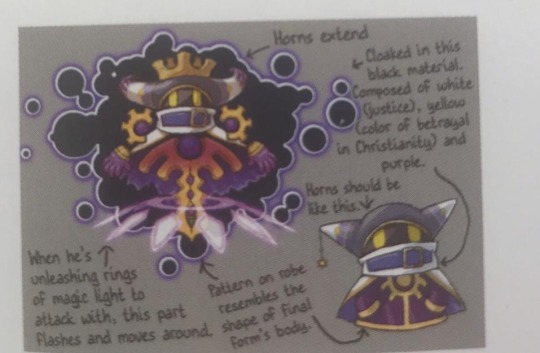
this doesn't mean much if you only look at return to dreamland 2011. it's simply a clever, blink-and-you'll-miss-it piece of his character design that ties with the fact that he betrays kirby. some fans also found this funny regarding his symbolic link to apples, which he uses as bombs or. uh. microtransaction materials. lol.
however, once return to dreamland deluxe came out in 2023, the game dropped a MASSIVE bomb of their own by providing us with a new, post-game epilogue for magolor. spoilers ahead, obviously. via the epilogue, magolor's link to apples is explored in-depth by putting him through trials where he must collect 5 fruit (apple) fragments, which a game screen implies parallel the fact that magolor tricked kirby into collecting the 5 parts of the lor starcutter. that's essentially his "penance" process.
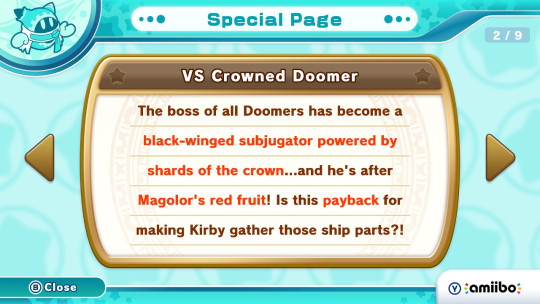
when magolor finished rebuilding the apple, which is known as the "ethereal alter" in english and the very unsubtle "room of eden" in japanese. the master crown that magolor had betrayed kirby for and stolen from its place on halcandra became a massive gem apple tree final boss. however, the tree itself is not listed as the boss--instead he is fighting the master crown itself.
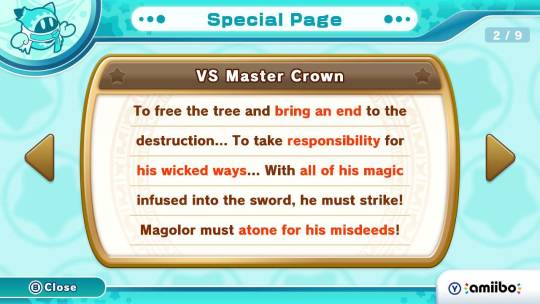
he ultimately destroys the master crown, which had taken the form of the "forbidden fruit" that had tempted magolor into hurting people, including those he had come to genuinely deem friends, for the sake of obtaining personal power. the gem apple being constructed in the "room of eden" is enough on its own to build a base for a christian theme, but magolor's arc of redeption through either 1. trial and repentance (main gamemode with magolor epilogue; self-imposed; successful) 2. outside aid (extra mode + true arena; extended by kirby; failed) is what allows the christian imagery to shine.
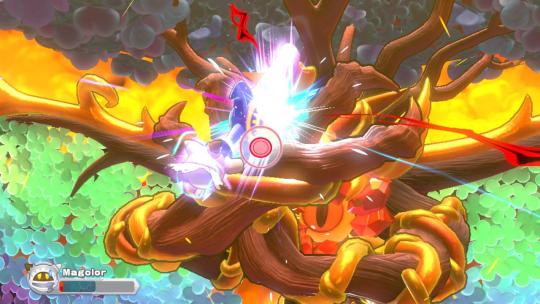
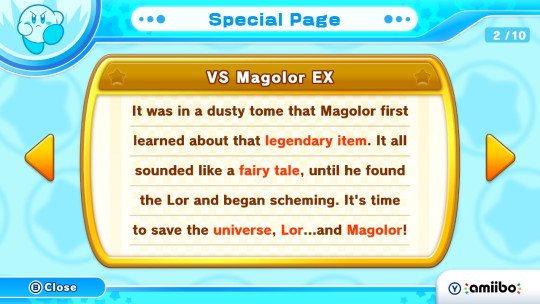
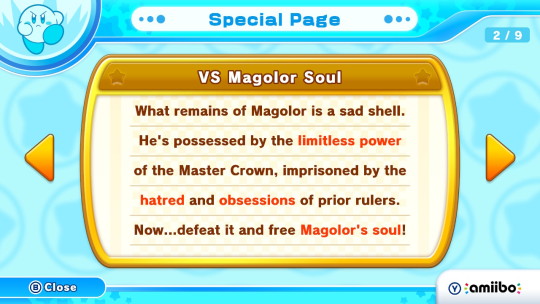
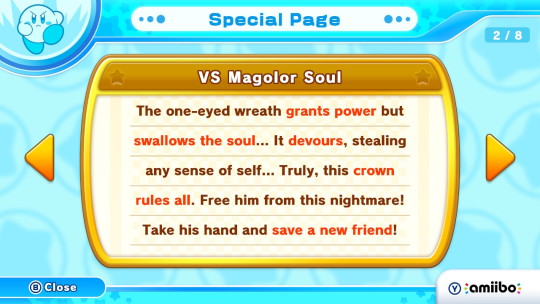
however, his christian imagery chronologically extends past the return to dreamland deluxe epilogue, as that same epilogue confirmed that "microtransagolor" (the green magolor from kirby clash deluxe) is the same magolor from return to dreamland. he nurtures the gem apple seed which he obtained after defeating the master crown in that game. clash deluxe also introduces us to a weekly "magolor day," which, you guessed it, is on sunday, with the first of them occuring on an easter.

the major reason why i connect magolor to christianity in particular rather than all abrahamic religions is the judas connection, the easter sunday thing, and the process through which he repents or "must atone for his misdeeds." while genesis isn't exclusive to christianity, the specific actions which magolor takes along his path of betrayal and redeption mirror make more sense to me as a christian moral tale rather than judaic or islamic for some reason. not sure why, i'd have to unpack that elsewhere.
this isn't to say that kirby is indoctrinating children into christianity or whatever ofc. considering the whole hyness and mage sisters deal in star allies, the connection between kirby and religion as a whole isn't always a positive one. nintendo also tends to avoid real life religions and references to them as a whole in their games likely to avoid controversy and to make their games accessible and understandable to a worldwide audience with a wide variety of cultural backgrounds. that last point is WHY i find it super crazy that magolor has an obviously and intentionally christian narrative.

(also, for the books, i'm not catholic. but i think 4 years of catholic school and a catholic grandmother gives me juuuust enough background/authority on the topic to relate it to kirby)
46 notes
·
View notes
Text
One of my all-time favorite antagonist organizations in the entirety of DC is the Court of Owls, and it's a guarantee that I'll eat up anything that features them. But my favorite thing in regards to them is the fact that Dick Grayson could've very easily been a Talon.

Case and point!
I dislike the New 52 era of DC for a number of reasons, but one thing I do think they got right was specifically how they handled the Court of Owls in regards to both Bruce and Dick, and the dialogue in this sequence here is some of the best in my opinion purely because of the reveal of what could've been had Bruce been just a little later to bringing Dick into his home.
If you look at Nightwing and consider just how powerful he is on his own as an unaltered human, and if you look at the Talons and how viciously deadly they were against the various members of Batman's family, and then you combine them?
Obviously, taking into account the different way Dick would've been raised means assuming he would lose some of his leadership and detective capabilities because— considering that Talons are all essentially mindless assassins that have to be told what to do and when to do it at every moment— he never would've had the opportunity to be an individual, or to be a leader, or to have thoughts for himself that would allow him to problem solve.
But if we're looking at lethality specifically, substituting those features for the electrum injections that would give him superhuman healing and senses, and the training that would teach him to disregard pain and emotions would remove the human limitations that he would be otherwise restricted by.
Combined with Dick's acrobatic flexibility (assuming the Court would allow him to continue maintaining it, with its many uses and advantages), the Court's training to withstand a multitude of different circumstances in battle would turn him into one of the most useful weapons in their arsenal.
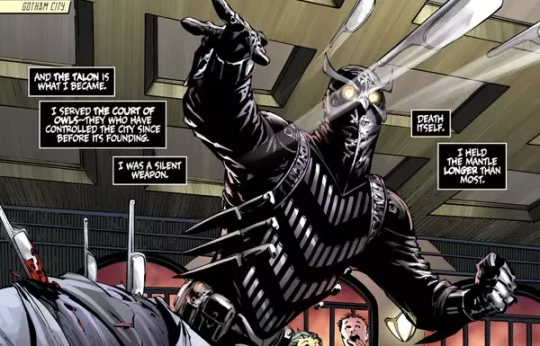

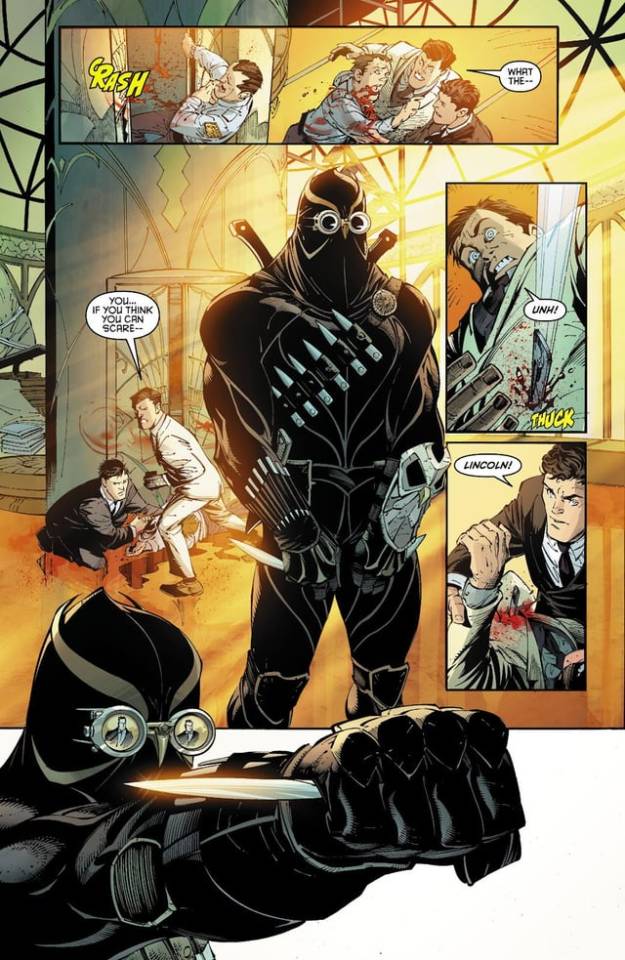

The imagery of the Talons, as seen above, is also incredibly fitting to the themes of Dick throughout the years. The most glaring and obvious of which is the bird symbolism, which I'll refrain from going into detail about because of how obvious it is.
But there is definitely a fairytale-esque quality to them with the nursery rhyme that, in my opinion, fits very well with Dick's upbringing in a circus.
Circuses are often all about maintaining a certain level of illusion, painting a picture to portray a story about each act that is, usually, exaggerated for the sake of entertainment. Similarly, the Court utilizes the belief that they're nothing more than a wives' tale to allow them to continue operating from the shadows. At the same time, the rhyme itself paints them as this otherworldly, all-knowing, all-powerful entity and dissuades any thoughts of acting against them on the off chance that someone does believe they really exist. It's whimsy, in the same way that a circus is, because they're using a story and attempting to make the most of how people receive said story.


The story parallels to Dick becoming a Talon instead of Robin also scratches a very particular itch in my brain. There are two paths, but both of them are intrinsically interwoven with Gotham and Batman.
Dick becoming Robin means him joining Batman on the side of protecting Gotham and her denizens from harm and injustice. He doesn't kill because Batman and Robin aren't the judge, the jury, and the executioner. He maintains his humanity despite the literal physical limitations of a human body and the mental and emotional burdens that come with having free thought, morals, and ethics to take into account.
But Dick becoming Talon means joining Cobb and the Court also on the side of Gotham, but from a different perspective. The Court is made up of Gotham's elite— the rich, famous, and powerful who all want control but don't want the target on their back from being publicly in control. He'd be maintaining the skewed perception of what is just and unjust that the Court instills within him. In turn, this would mean fighting against Batman, who undeniably goes against the wishes of the Court's members who profit and benefit from the corruption of Gotham.
There is a sense of devotion that makes them different sides of the same coin, however. The Talons are tortured and brainwashed into submission, forced to ask "how high" when told to jump. Dick throughout his various comic appearances, has shown his intense loyalty to Bruce— a loyalty that rivals that same devotion of the Talons to the Court, especially in his younger years as Robin.
In conclusion to this tangent, Dick Grayson becoming a Talon was meant to happen, that is undeniable, but Bruce Wayne stepping in and stopping that (albeit unknowingly) is the only reason the Court doesn't have a near undefeatable weapon to use as they see fit.
Which just makes me wonder what other disastrous outcomes were avoided by Bruce taking in the other children.
#dick grayson#dc comics#nightwing#robin#batman#bruce wayne#court of owls#talon#the new 52 and i have beef but i will begrudgingly admit to loving how it handled the court of owls
31 notes
·
View notes
Text
I know the plot of the next ACOTAR book
Your girl’s back with a new theory and this time, it’s more receipts from ACOFAS. Continuing with my theory (link) that the next two novels in the ACOTAR series will be about Elain and Mor (in that order), I went back to look at the structure of ACOFAS and for any more clues on Elain’s book 🧐

Last night, something hit me on my latest reread. I wanted to look at how Cassian’s introductory chapters unfolded through a lens of what we now know of his and Nesta’s story in ACOSF, and use those parallels to look closer at Azriel and Elain’s chapters (as narrated by Feysand).
So let’s dive deeper…
THE EVIDENCE
Exhibit 1
In Chapter 2, we start with Rhysand’s POV. Here are the first 3 sentences.

🔻 Cassian was already pissed — the start of ACOSF has Cassian and Nesta both frustrated and at their lowest/feeling like failures (Cassian with the Illyrian problem, Nesta with herself/her sisters/her father's death).
🔻 the Illyrian Mountains — training and the climax of ACOSF all surround them and Ramiel (which is also featured in Chapter 3 when Cassian flies by it).
🔻 the gray peaks — characters in ACOTAR are continuously referenced with repeating colors, and Nesta’s most notably is gray (sometimes referred to as steel, which is a fun double entendre with weaponry).
And in Chapter 3, we have Cassian’s POV. Here are the first 3 paragraphs:
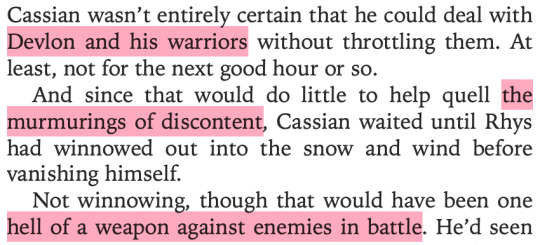
🔻 Devlon and his warriors — the Illyrian warriors are antagonists against Nesta in the Blood Rite
🔻 the murmurings of discontent — the motivation for that growing threat that Nesta faces in the Blood Rite and the patriarchal legacies that the Valkyries are upending
🔻 hell of a weapon against enemies in battle — Nesta’s new trove of weapons she Made: the greatsword, sword, and dagger.
In both of these chapters, there are other recurring themes and imagery, including The Blood Rite, Ramiel, fire/campfires/embers, and more interestingly, Cassian visiting his mother’s unmarked grave, something that Nesta literally does when she visits her father’s grave at the very end of ACOSF.

Every major plot that Nesta and Cassian faced as a couple was explored in the first two chapters reintroducing Cassian for the spinoff series.
Using this evidence, we can deduce that the next chapters exploring Azriel will feature the same sort of foreshadowing, setup, and potential payoff in the upcoming novel (which I predict will be Elain’s book).
Exhibit 2
In Chapter 7, we start again with Rhysand’s POV. Here are the first 3 paragraphs:
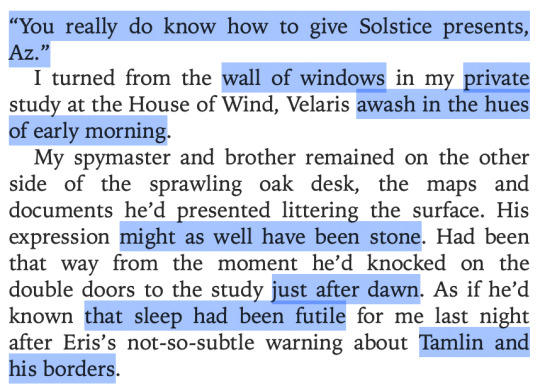
🔹 You really do know how to give Solstice presents, Az — We all know about the necklace for Elain at this point. But also interestingly, Elain gives Azriel two significant Solstice gifts, one of which he keeps by his nightstand to longingly look at every night, the other a pair of earplugs (which we can deduce will have their use in the upcoming book).
🔹 wall of windows — something I’ve noticed (and want to dive deeper on later) is that both Azriel and Elain are often associated with windows.
Azriel: grew up in a lightless, windowless room; stares out the window of the townhouse to the garden during ACOFAS, presumably to watch a gardener at work; in the HOW lounge area, his unofficial chair is nearest to the window.
Elain: during her time after becoming Fae, she sat near the bay windows in the HOW; during ACOFAS Solstice, she watches the snow fall outside the windows before Azriel joins her there; her smile was described by Nesta as being as bright as the setting sun beyond the windows.
Windows can symbolize freedom, desire to explore, and pathways to the outside world. They also focus on providing sight, something very important to a Seer who can look beyond the world in front of them to something more, but I digress!
🔹 private — Azriel is described as the most private, secretive of the Bat Boys (with both his emotions and his lovers), so I thought it was worth noting.
🔹 awash in the hues of the early morning — only one character is consistently described as glowing like the sun at dawn (even by Azriel himself, no less).
🔹 might as well have been stone — there is a wealth of repeating imagery of Elain associated with stone: sitting on a stone bench with her father surrounded by blue and pink flowers (haha, I see you SJM), Elain washed onto the stone floor by the Cauldron after becoming Fae, Elain hearing a heartbeat through stone, etc.
🔹 just after dawn — I see you again, SJM 😏
🔹 that sleep had been futile — although this is about Rhysand being tired, there is a wealth of sleep imagery surrounding both Azriel and Elain. Most notably Azriel’s inability to get a goodnight’s rest the past year as he’s been thinking of Elain at night. And Elain, who says she feels like “she’s always dreaming these days” in regards to her Seer powers.
I also want to dive into the sleep imagery surrounding these two and their potential Sleeping Beauty ties. But alas, a post for another day.
🔹 Tamlin and his borders — Conflict with the Human Lands, similar to Cassian’s with the Illyrians and the growing discontent, which then ties into the next part of the chapter.
Rhysand and Azriel move on to the next conflict at hand: Vassa, the Human Lands, and the sorcerer-lord’s curse, which they discuss after deeming Cassian to handle the growing Illyrian conflict, leaving Azriel to “continue to watch [the human queens]” and the “strange gathering” happening in the human lands. We also learn that the curse on Vassa by the sorcerer-lord might be woven into [Vassa’s] very blood (put a pin in this).
Finally, Rhysand and Azriel turn their attention to how they might get a handle on the situation to the south:
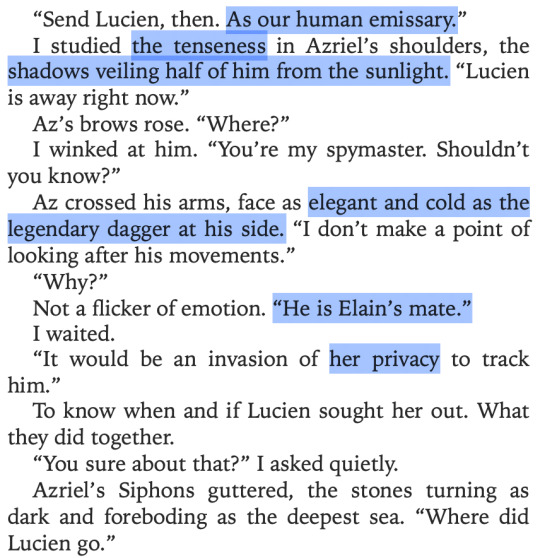
🔹 As our human emissary — While Lucien may have been considered the human emissary to the Night Court during ACOFAS, per Mor in ACOSF, Lucien can no longer be trusted as he is now living with Vassa and Jurian in the human lands. Does this perhaps leave an opening to a new human emissary of the Night Court? Maybe even Elain, who could convince anyone with a few smiles.
🔹 the tenseness — interesting of Rhysand to point out considering Azriel is usually impossible to read. Something is stressing him about this situation causing some sort of internal conflict
🔹 shadows veiling half of himself from the sunlight — an interesting parallel to the iconic carved, wooden rose scene in ACOSF when Nesta places the rose the exact same way, half-hidden in shadows.
🔹 elegant and cold as the legendary dagger at his side — elegant and cold are repeating descriptors for Azriel and Truth-Teller’s significance after HOFAS has only grown. 🗡
🔹 “He is Elain’s mate.” — one of our next conflicts: Elain’s mating bond (which is also supported by Azriel’s BC).
🔹 “invasion of her privacy” — interesting to me that privacy is brought up again… perhaps alluding to something secret or forbidden?
Towards the end of their discussion, Rhys and Azriel move on to Cassian's favorite subject, Bryaxis:

🔹 “No word on Byraxis, I take it.” / “Do you want me to hunt it down?” — Like hunting for the troves in ACOSF, I believe Azriel will hunt Bryaxis down in the next book. Given how he’s an ancient, shadowy monster, I’d be curious how Bryaxis could perhaps provide incite into Koschei 👀 Also, what does Bryaxis want installed in the library? A goddamn window.
🔹 beneath this mountain — perhaps we’ll see underneath another mountain explored, given Eris’s parting words to Cassian and Nesta at the end of ACOSF 🏔
🔹 My brother had a sly, wicked sense of humor — this also aligns with Elain, whose Solstice presents to Az have both been cheeky and made him laugh.
From this chapter alone, we can see the major plot points building: Azriel spying on the human lands, Vassa’s curse and Koschei’s control over her, Bryaxis still on the run, Truth-Teller’s significance, and Elain’s mating bond.
Which finally leads us to Feyre’s chapter where Elain is front and center.
Exhibit 3
In Chapter 15, Feyre and Elain visit the weaver’s shop while looking for Solstice presents for their family, where a very interesting conversation goes down:

🌸 the weaver paused the loom — similar to the the curse woven into Vassa’s very blood, weaver imagery surrounds the conflicts of both Vassa's curse and Elain’s mating bond, especially as mating bonds are described as threads, particularly as one tied to a rib by Elain. This also aligns with the multitude of Sleeping Beauty imagery surrounding Elain.
🌸 my sister’s gaze — lol, I mean, I love when SJM does this over and over. We know Elain’s gaze is special as a Seer.
🌸 “I call it Hope.” — Elain, who is constantly described as hope and having a different sort of strength, which aligns with Azriel, who Rhys declares taught him how to hope. Perhaps Elain and Azriel are connected by an iridescent, living silver thread that is bright despite the darkness?
🌸 “I made it after I mastered Void.” — Elain’s Seer abilities are often described as the murky realm, a void that she needed to be freed from when Azriel recognized her powers. She declares in ACOSF she can start reacquainting herself with her powers to help the Inner Circle. Since Nesta stepped in, we haven’t seen her truly do this yet. Also… the weaver Made it 😜
From this small conversation, we can see SJM is playing with classic Sleeping Beauty fairytale imagery and how it connects to Elain as not just a Seer, but as a light in the darkness. I believe for Elain’s book where she finds her voice, we will see her master the Void, aka her Seer powers, and perhaps weave something made from Hope, like a mating bond and healing Vassa’s curse.
CONCLUSION
SJM clearly laid out the stories to be explored in the next books with ACOFAS, a plan she said she’s had for years. This does not mean that we won’t see more from our other favorite characters (looking at you, Nesta and the Valkyries).
But based on the evidence I shared last time that Elain’s book is unequivocally next, here we can see that the storylines set up in ACOFAS were paid off for Cassian and Nesta in their book.
So, I can without a doubt say we know what’s coming:
Elain’s book, where she will explore the main conflicts of the growing threat in the human lands as possible human emissary, her mating bond with Lucien, her feelings for Azriel, mastering her Seer powers, Hope vs the Void, and breaking Vassa’s curse.
I can’t wait for the book announcement in the months to come for our favorite flower girl 🌸
Next time, I’ll explore Mor’s first chapters in the Hewn City and why I believe her story will be paired with the defeat of Koschei (There was no light in this place and eternal darkness dwelled in the Hewn City, anyone?).
Thanks for reading 💖
#acotar#acotar theory#acotar thoughts#pro elriel#elriel#elain archeron#pro elain#azriel#elriel supremacy#azriel x elain#elain x azriel
124 notes
·
View notes